SEO
What Is Topical Authority in SEO & How to Build It
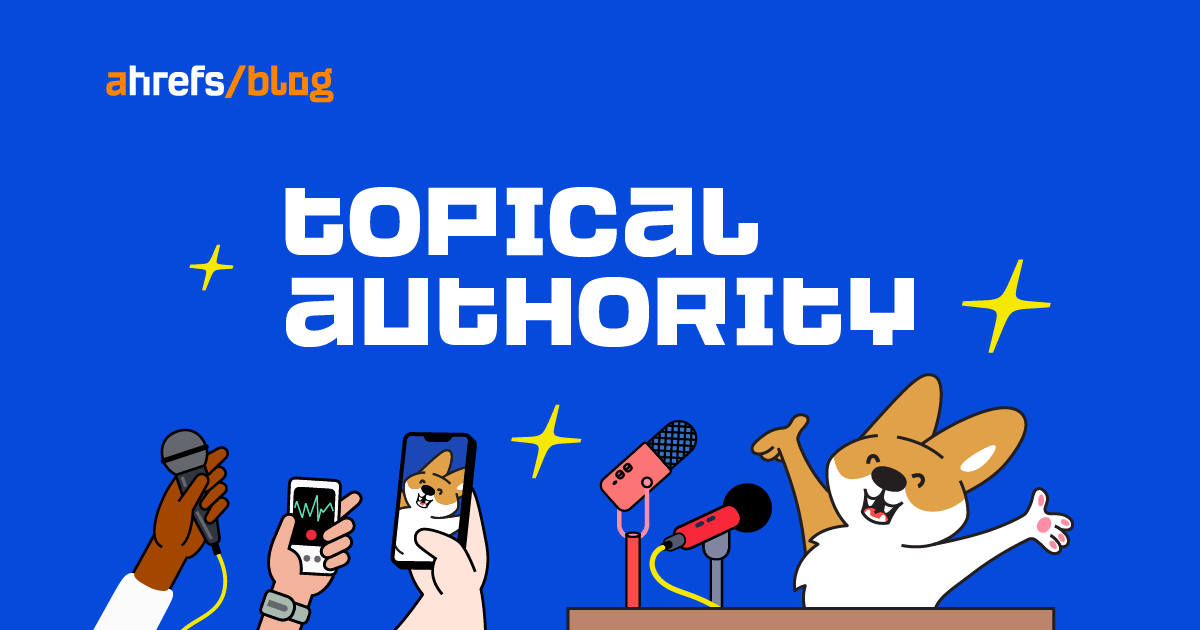
Imagine if your website (or clients) could rank for every single keyword related to a desired niche.
Enter topical authority.
Now imagine that you could even achieve this with no link building.
If some people in the SEO world are to be believed, this is achievable by anyone willing to write content about absolutely everything within a topic.
But realistically, you should still expect to build links and do a lot of other SEO activities. Topical authority is not a silver bullet.
But it’s still worth your time.
In this guide, you will learn everything you need to know about topical authority and how to build it for your sites.
Topical authority is an SEO concept where a website aims to become the go-to authority on one or more topics.
Building topical authority is about helping search engines understand a website’s topic so that it has better potential to rank for topically related keywords.
Let’s say you want to rank articles around the topic of protein powder. Writing just the one article targeting “protein powder” is probably not enough to compete in this niche.
Why? Because it’s a massive topic and you can’t possibly cover everything about it in one article.
To build topical authority, you need to cover everything related to protein, such as:
- “what is protein”
- “what does protein powder do”
- “what is the best protein powder”
- “how to use protein powder”
- “how long does protein powder last”
- “how to use protein powder for weight loss”
Topical authority is achieved when a site fully covers a topic as a whole rather than focusing on just individual keywords.
If you’ve spent any time digging into the SERPs looking for SEO opportunities (and let’s be honest, you have), you’ve probably noticed sites with low Domain Rating (DR) scores ranking well—thanks to topical authority.
For example, check out the SERPs for the keyword “mountain bike gifts”:

At first glance, you’d expect to see a big e-commerce store like Amazon (DR 96) at the top of the search results for a product-focused keyword like this.
However, a DR 23 site is ranked in second place, well above Amazon.
Why is this?
Possibly because twowheeledwanderer.com is a site all about the topic of bikes. Whereas Amazon (although much stronger in terms of SEO metrics) lacks the topical authority for its domain, as it sells more general stuff.
Although it should also be noted that search intent plays a big part here too. Amazon is the only page on these SERPs ranking with a product category page, whereas the rest are articles/gift guides.
This is just one example where a website with topical authority has outranked more established players.
Google, as a search engine, works with semantic associations. This means it has to associate a website with a topic in order to rank it as a relevant resource for keywords that are part of that topic.
If you have a lot of content about a certain topic, this allows for more relevant internal links, which allow Google and users to find your content more easily which, in turn, may land you more natural backlinks.
If you take away nothing else from the concept of building topical authority, take this:
When you create content pieces around the same subject and interlink them, your topical authority in the eyes of Google increases. This helps to show it that you’re knowledgeable, aka an authority on the topic and a trusted source.
Before we go any further, let’s discuss the elephant in the room:
Spoiler for this section: No one really knows.
With the introduction of Google’s Hummingbird algorithm in 2013, topical authority became increasingly important.
It changed the ranking system for content so that it was determined by relevance to a user’s search query.
Prior to Hummingbird, keywords were the main emphasis of Google’s search algorithms. In order for Google to understand what a user was looking for, keywords were used.
However, Google simply couldn’t understand the context behind user searches.
A (very) brief history of Google and authority
Over the years, Google has moved more toward semantic search:
- 2011 – Google announces “Structured Search Engine” for structuring the information on the web.
- 2012 – Google launches Knowledge Graph for better understanding information about real-world entities.
- 2013 – Hummingbird algorithm ranks sites based on inbound links and keywords. Google can now rank content based on relevancy to a query.
- 2018 – Google’s Medic update means YMYL content needs to show expertise, authority, and trustworthiness (E-A-T) in order to rank.
- 2019 – BERT is launched. It is a model for better understanding relationships between words, concepts, and entities in human language.
You can’t really talk about topical authority without mentioning E-A-T at some point.
E-A-T (expertise, authority, and trustworthiness)
Google’s emphasis on “expertise” and “reputable websites” can be seen in its Quality Rater Guidelines:
Highest quality pages and websites have a very high level of expertise or are highly authoritative or highly trustworthy.
This suggests that building a reputation for your website as a “subject matter expert” is likely to contribute to the “authority” aspect in E-A-T.
While E-A-T is not a direct ranking factor, the concept helps to inform the ranking algorithms. So when Google views your website as an expert resource on a topic, it’s more likely to rank your content higher.
Learn more: What Is E-A-T? Why It’s Important for SEO
The lack of clarity around the whole concept of topical authority contributes to having no definitive way to measure it.
Sure, more rankings and more traffic may be a good sign. But they just as well may be a result of link building or other SEO activities.
Thankfully, there are smart people like Kevin Indig, who devised a way of roughly calculating topical authority using the Traffic share by domains report in Ahrefs’ Keywords Explorer:

Here’s how to calculate the proxy to topical authority in Ahrefs:
- Take a head term like “ecommerce” and enter it in Keywords Explorer
- Go to the Matching terms report and filter for a minimum volume of 10
- Export all keywords and reupload them into Keywords Explorer
- Go to Traffic share by domains
- Traffic share = topic share aka “topical authority”
So how do you build topical authority for your site?
First, you need to cover all the obvious SEO basics. Assuming you’ve got the basics covered, building topical research is pretty straightforward.
In very simple terms, you need to:
- Do keyword research to find all the talking points within a topic.
- Organize that data into topic clusters.
- Produce content that meets the search intent of those topic keywords.
- Build relevant internal and external links to your content.
At the risk of becoming an authority on the topic of wasting time by rambling on about things no one really knows other than Google…
Let’s crack on and learn how to build some topical authority.
1. Do topic-based keyword research
It should come as no surprise that the starting point for building topical authority is keyword research.
Identifying queries that users are searching for and topics of interest is the beginning of most SEO projects, and building topical authority is no different.
To be considered a “topical authority” by Google, you need to find and write about all the talking points within a topic.
Sidenote.
Google’s main goal is to give people the most relevant answers to their search queries as quickly as possible. Your focus should be the same. Instead of thinking about an article as focused on a single keyword, think of them in terms of topics and subtopics. You’ll want to try and cover everything in your content that Google expects to see.
Choosing a good seed keyword is the foundation of your topical research.
Identifying a seed term that is relevant to your topic is key. Here’s how to approach picking a good seed keyword for doing topical keyword research:
| Topic | Good seed keywords | Bad seed keywords |
|---|---|---|
| coffee roasting process | coffee roasting coffee roasters |
coffee roasting |
| taking care of dogs | dog care dog health |
animals dogs |
| all kinds of mountain biking | mountain bikes mountain bikers |
bicycles bikes |
| Why are they good/bad? | Clearly focus on the topic | Too vague/specific; potential for lots of irrelevant KWs |
Struggling to think of useful seed terms?
Try and pick seed keywords that represent an entity in Google’s Knowledge Graph. Entities in SEO are a complex subject and far beyond the scope of this article and my soft monkey brain to tackle right now.
So for the purpose of speeding up seed keyword selection, I’ll use entities straight from the horse’s mouth:
- Go to Google Images
- Drop in my broad topic
- Check out the image filters (these are the entities that Google associates with the topic)

Once you have selected a seed keyword, it’s time to expand the list.
For example, let’s say you want to build topical authority around the topic “project management software.”
You’ll want to create content around keywords like:
- “project management software benefits”
- “project management software for students”
- “project management software definition and examples”
- “best project management software”
- “project management software for business”
To get to this point is relatively simple, although it can be time consuming.
Drop a broad seed term in Keywords Explorer. The overview acts as a good starting point for understanding the topic.
Continuing with the topic of “project management,” here’s what you want to pay attention to:
Top-ranking result
As the name suggests, this is the top-ranking page for the target keyword:

This is a great starting point for research. At a glance, you can see how many keywords this single page is ranking for:

Given that this is the top-ranking result, the keywords here are usually key subtopics you’ll want to cover—or at least provide an indication of.
Keyword ideas and questions
Still on the “Overview” panel, you can quickly see the top questions being asked around the topic:

SERPs
One of the best places to get more SEO data is on the SERPs, and topical keyword research is no different.

What I like to do here is expand the list to show the top 100 ranking pages (click Show more) and then cherry-pick low-DR sites that are ranking for a good number of keywords.
This site stood out to me because it is DR 32 with a little over 200 keywords and ranking in a sea of DR 70+ sites.

This is a good sign that this site has a good amount of topical authority for me to leverage in my own research.
Traffic share by domains
It’s also worth hopping over into the Traffic share by domains report. This report shows the domains that get the most organic traffic based on your seed keyword input:

This is useful for seeing who are your major competitors, which you can use as sources of more keywords. Cherry-pick domains and drop them into the Content Gap tool to uncover more keywords.
Here’s how to uncover more terms from competing domains:
- Run your site through Site Explorer
- Go to the Content Gap tool
- Pick suitable domains from the Traffic share by domains report
- Apply some filters (if you want)
- My preference: filter by keyword—in this example, “project management”—and some minimum volume and KD scores

Now that you have a list of keywords for topics (that get searched), it’s time to make sense of the keyword data.
2. Create topic clusters
Topic clusters are interlinked pages about the same subject. The purpose of them is to group relevant content together so that it is easier to find by both users and Google.
Armed with your keyword research, you’ll want to organize your list of terms into clusters based on search intent while also considering traffic potential.
Your topics should have good traffic potential and typically be informational in intent, like this:

Pick a topic for your cluster (or pillar page) that is relevant for your site to target and has enough depth that you will have subtopics to explore.
Now, you’ll want to pick the most appropriate content format to create for the cluster:
- Guides – An evergreen content format that fully covers a specific topic.
- What is X – A deep-dive definition or answer to a question.
- How to X – A step-by-step tutorial detailing how to do a specific task.
These pages should be well structured with enough content to be useful as stand-alone articles but also link to more in-depth articles within the topic.
Once you have your topic pillar nailed down, you’ll want to go “more niche.”
Just taking a quick look at the “how to get into project management” example, we can see more potential subtopics to target:

These pages should be fairly comprehensive and link to other topic pages and cluster content.
Linking between your pages is vital for topical authority. Doing so helps build a semantic relationship between those URLs, telling Google that these pages are topically related.
3. Write authority content
Now it’s time to take your keyword research and topic clusters and create some content.
The way to establish topical authority that most people are familiar with is by creating in-depth content.
Start with your main pillar content pieces. Generally, you will want to have a pillar page for every type of product or service you provide or the main area of the subject you want to be seen as an authority on.
These focus topics should be broad enough that they have subcategories to target but also specific enough that a searcher landing on your page will find them relevant.
Ahrefs’ beginner’s guide to SEO does a good job of acting as an overview of the topic, and then directing users to more specific parts of the topic (in the stand-alone chapters):

Next, you’ll need to write supporting content.
Instead of writing about a topic in general, be more specific. Supporting pages should match user intent and are where you can gain more content depth.
You’ll typically find that these pages are the ones where you will target long-tail keywords.
For each piece of content you create to help build your topical authority, you’ll want to:
- Write quality content that aligns with your topic and what your audience actually wants to read.
- Keep E-A-T in mind.
- Cover as many topics and subtopics as you can.
- Match search intent (e.g., write a how-to guide for the [how to X] keywords, a list of benefits for [benefits of X], etc.).
- Internally link to different relevant topics.
- Continually update your content as it ages.
4. Build relevant links
Even the best content sometimes needs links to rank better.
When it comes to link building for topical authority, you need to make sure that the websites that link to you are relevant.

If you run a blog about coffee, getting a link from another bigger coffee website in your niche will be perfect. Whereas getting a link from a finance blog will be less relevant and, therefore, carry less weight. Relevance is the key.
Here are a few topical backlink tactics:
- Guest blogging – Create useful content for topically related websites.
- Skyscraper Technique – Create the go-to resource on the topic.
- Ego bait – Mention key players in your niche and reach out to them.
- HARO – Get “expert quotes” for your article.
Of course, it’s not just links on external sites you should be building but internal links on your own site too. In fact, these are pivotal for building topical authority.
Google uses internal links to help discover new content (source):
Some pages are known because Google has already crawled them before. Other pages are discovered when Google follows a link from a known page to a new page.
Each pillar page should be treated as a hub for that topic. Use internal linking to connect it to every piece of supporting content.
For instance, using the “mountain bike” example again, all your pages on tires, helmets, tools, etc., should link back to your pillar page on mountain bike accessories.
Still have questions about building topical authority? You’ll like the final section.
Here are answers to a few common questions you may have about topical authority:
What is topical relevance?
Topical relevance is the relevance that the content on a website has in relation to a particular topic. Search engines use it to determine how relevant a page is to a user’s search query based on factors like content, backlinks, and keywords.
What is semantic SEO?
Semantic SEO is the process of building more meaning and topical depth with content. This is used by search engines to return the most relevant search results. Semantic search focuses on the meaning behind search queries instead of traditional keyword matching.
Learn more: What Is Semantic Search? How It Impacts SEO
What is website authority?
Website authority is a metric created by SEO tool providers to measure the strength of a site’s backlink profile compared to other sites in their index.
Learn more: How to Increase Website Authority (Domain Rating)
Are there any data-backed topical authority case studies?
I’m glad you asked.
Topical authority is a massive subject. There’s a lot of work out there done by people smarter than me in this field. Here are some case studies you should check out:
Final thoughts
Although it can be a powerful tool for ranking on Google, topical authority is not a magic fix for all of your SEO needs.
It requires a lot of work and can take some time to kick in, but it’s worth pursuing if you want to rank for all the keywords in your niche.
Just keep this in mind and you can’t go wrong:
Write about everything your audience wants to know—even better if the keywords align with your product/service.
Got a question on topical authority? Tweet me.
SEO
56 Google Search Statistics to Bookmark for 2024
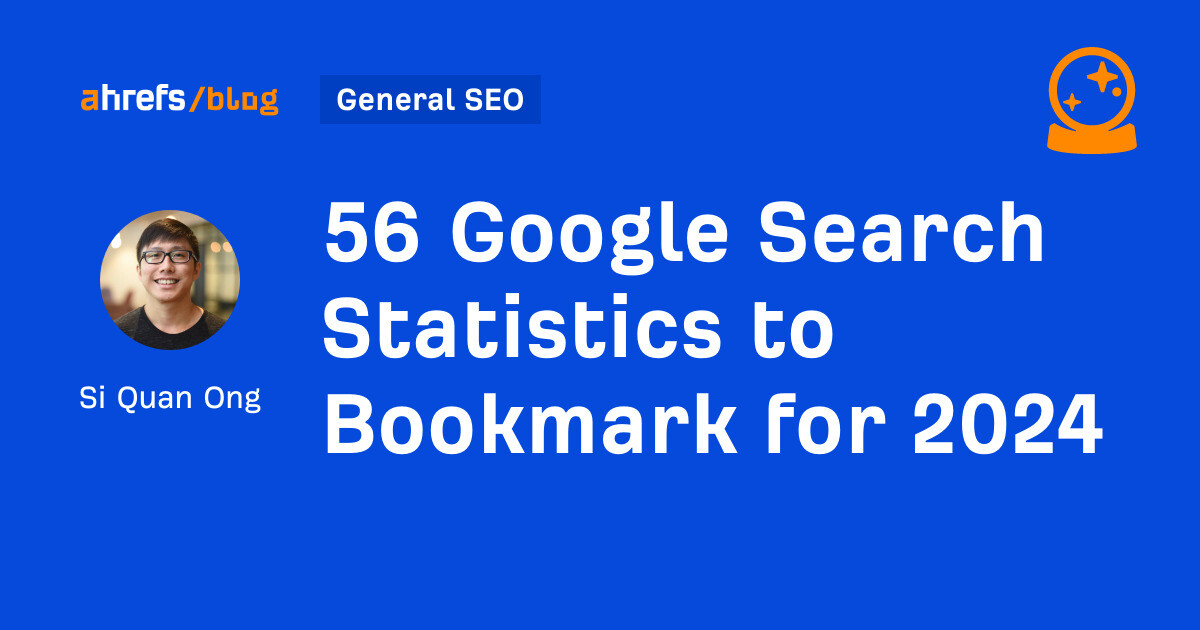
If you’re curious about the state of Google search in 2024, look no further.
Each year we pick, vet, and categorize a list of up-to-date statistics to give you insights from trusted sources on Google search trends.
Check out more resources on how Google works:
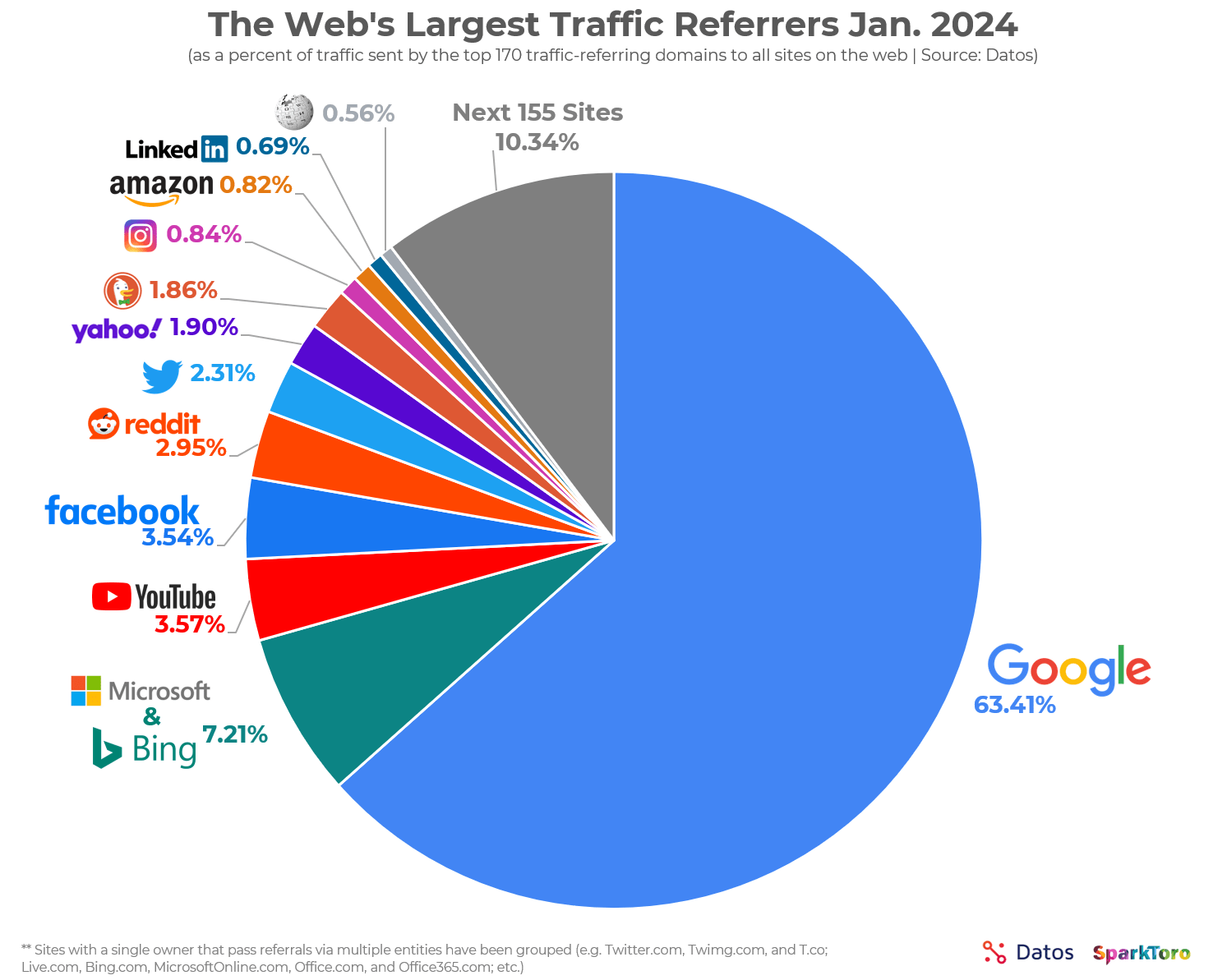

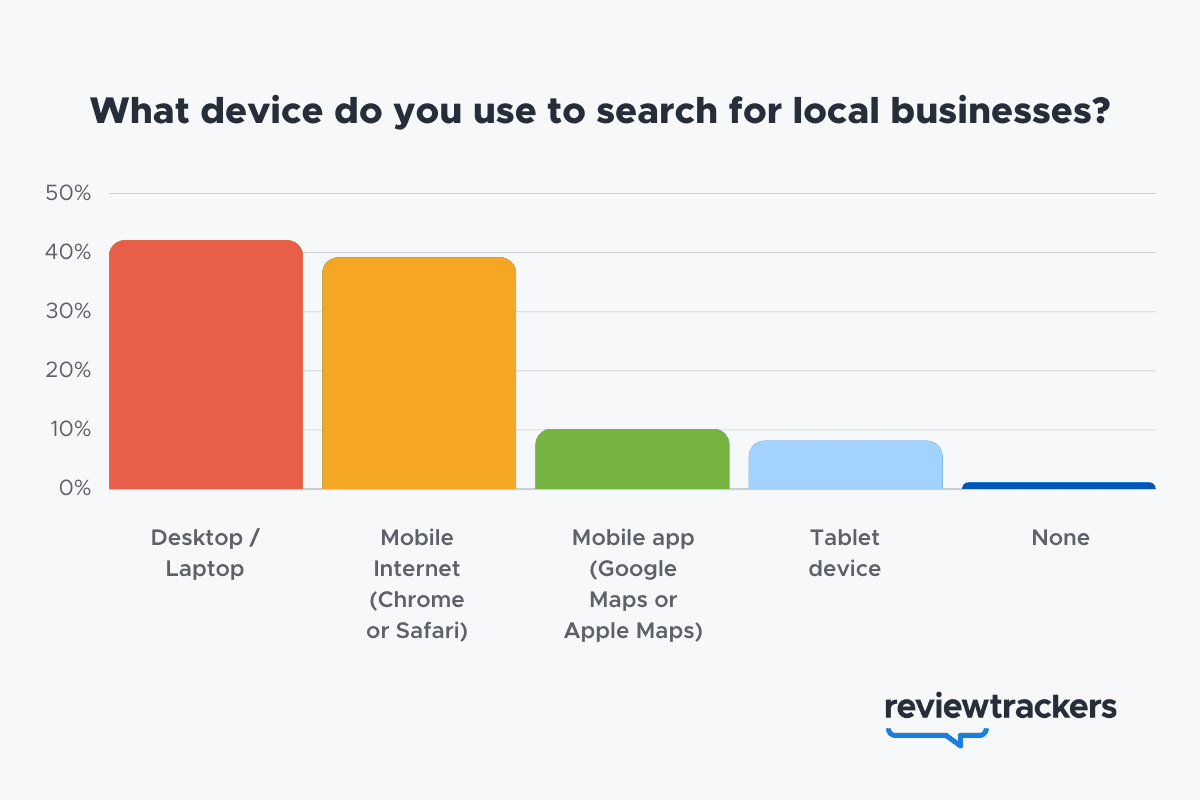

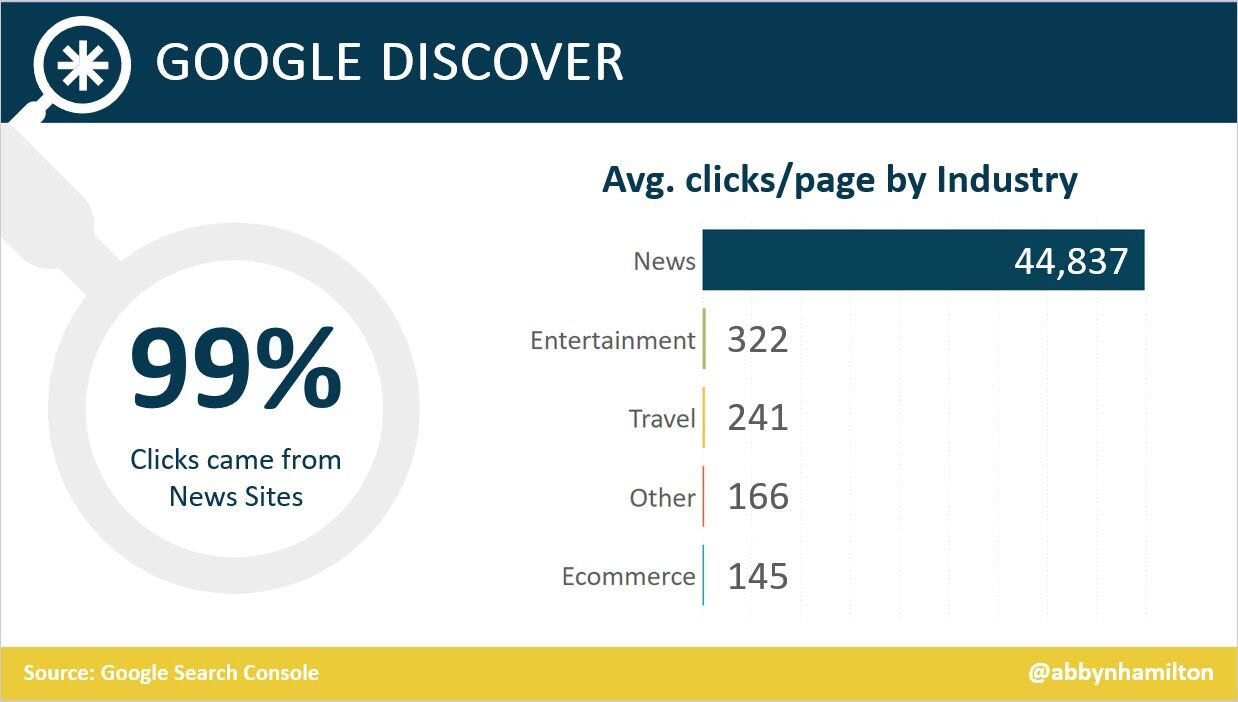

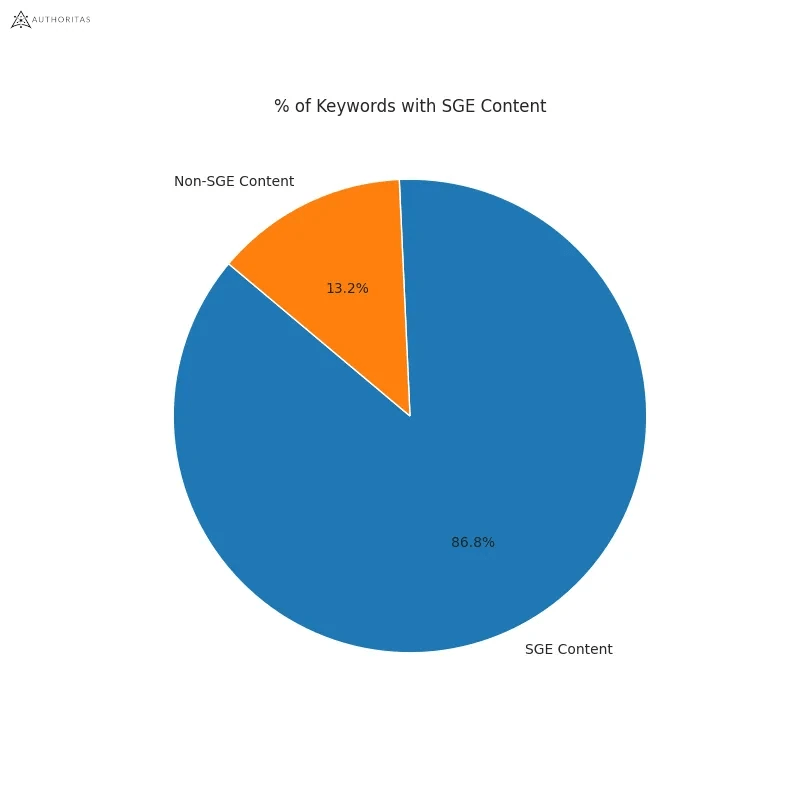

Learn more
SEO
How To Use ChatGPT For Keyword Research

Anyone not using ChatGPT for keyword research is missing a trick.
You can save time and understand an entire topic in seconds instead of hours.
In this article, I outline my most effective ChatGPT prompts for keyword research and teach you how I put them together so that you, too, can take, edit, and enhance them even further.
But before we jump into the prompts, I want to emphasize that you shouldn’t replace keyword research tools or disregard traditional keyword research methods.
ChatGPT can make mistakes. It can even create new keywords if you give it the right prompt. For example, I asked it to provide me with a unique keyword for the topic “SEO” that had never been searched before.
“Interstellar Internet SEO: Optimizing content for the theoretical concept of an interstellar internet, considering the challenges of space-time and interplanetary communication delays.”
Although I want to jump into my LinkedIn profile and update my title to “Interstellar Internet SEO Consultant,” unfortunately, no one has searched that (and they probably never will)!
You must not blindly rely on the data you get back from ChatGPT.
What you can rely on ChatGPT for is the topic ideation stage of keyword research and inspiration.
ChatGPT is a large language model trained with massive amounts of data to accurately predict what word will come next in a sentence. However, it does not know how to do keyword research yet.
Instead, think of ChatGPT as having an expert on any topic armed with the information if you ask it the right question.
In this guide, that is exactly what I aim to teach you how to do – the most essential prompts you need to know when performing topical keyword research.
Best ChatGPT Keyword Research Prompts
The following ChatGPT keyword research prompts can be used on any niche, even a topic to which you are brand new.
For this demonstration, let’s use the topic of “SEO” to demonstrate these prompts.
Generating Keyword Ideas Based On A Topic
What Are The {X} Most Popular Sub-topics Related To {Topic}?
The first prompt is to give you an idea of the niche.
As shown above, ChatGPT did a great job understanding and breaking down SEO into three pillars: on-page, off-page & technical.
The key to the following prompt is to take one of the topics ChatGPT has given and query the sub-topics.
What Are The {X} Most Popular Sub-topics Related To {Sub-topic}?
For this example, let’s query, “What are the most popular sub-topics related to keyword research?”
Having done keyword research for over 10 years, I would expect it to output information related to keyword research metrics, the types of keywords, and intent.
Let’s see.
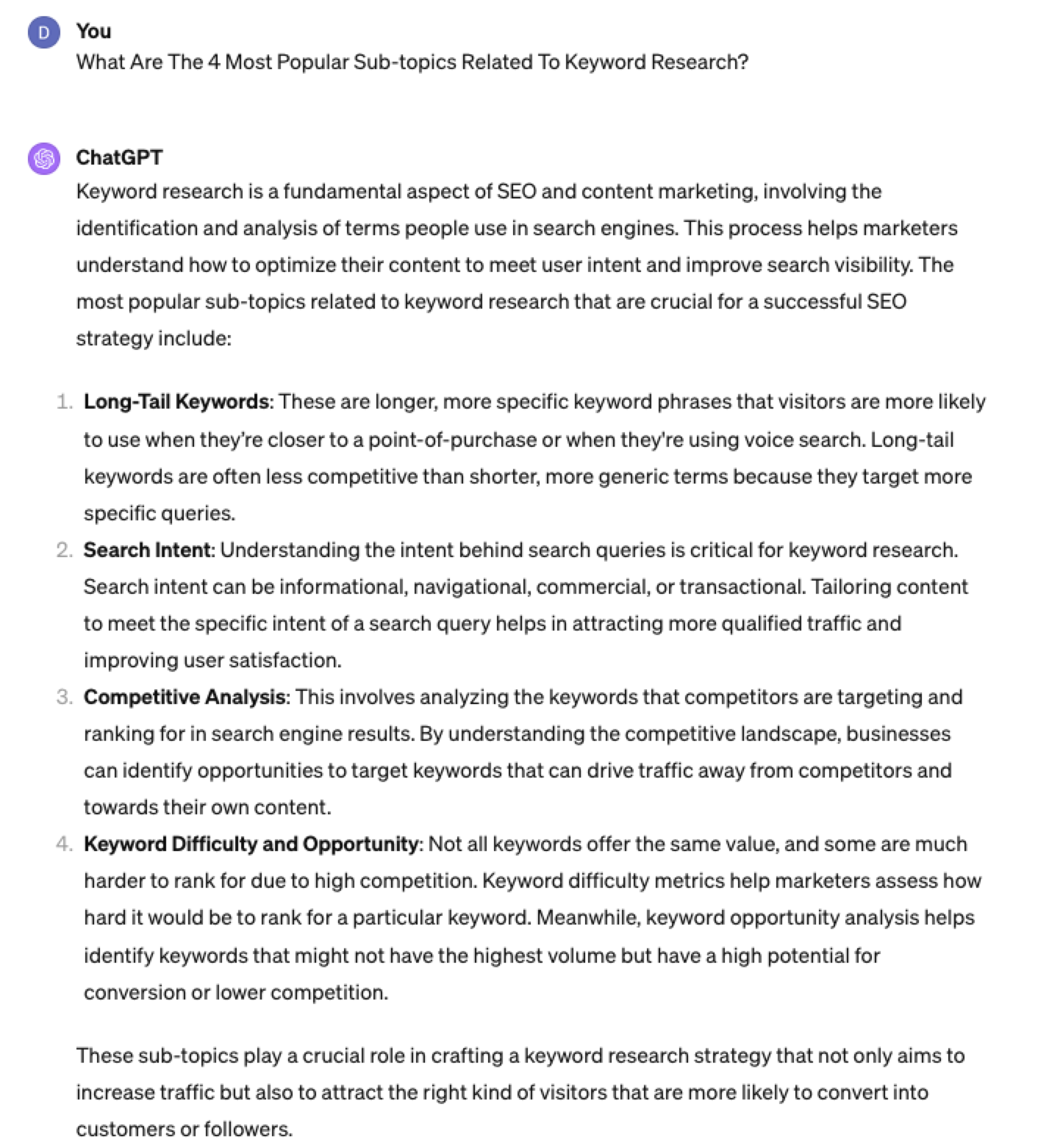 Screenshot from ChatGPT 4, April 2024
Screenshot from ChatGPT 4, April 2024Again, right on the money.
To get the keywords you want without having ChatGPT describe each answer, use the prompt “list without description.”
Here is an example of that.
List Without Description The Top {X} Most Popular Keywords For The Topic Of {X}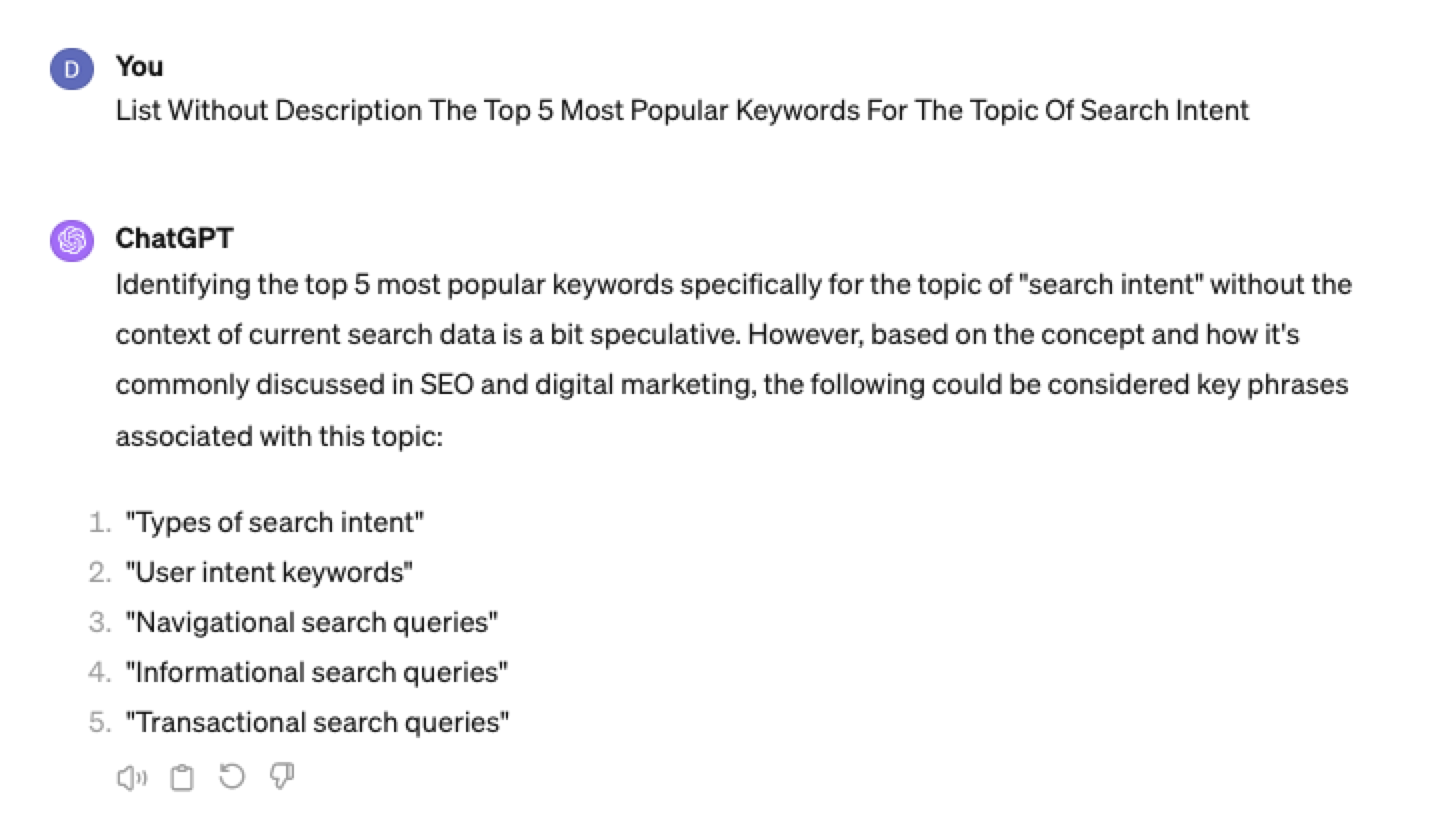
You can even branch these keywords out further into their long-tail.
Example prompt:
List Without Description The Top {X} Most Popular Long-tail Keywords For The Topic “{X}”
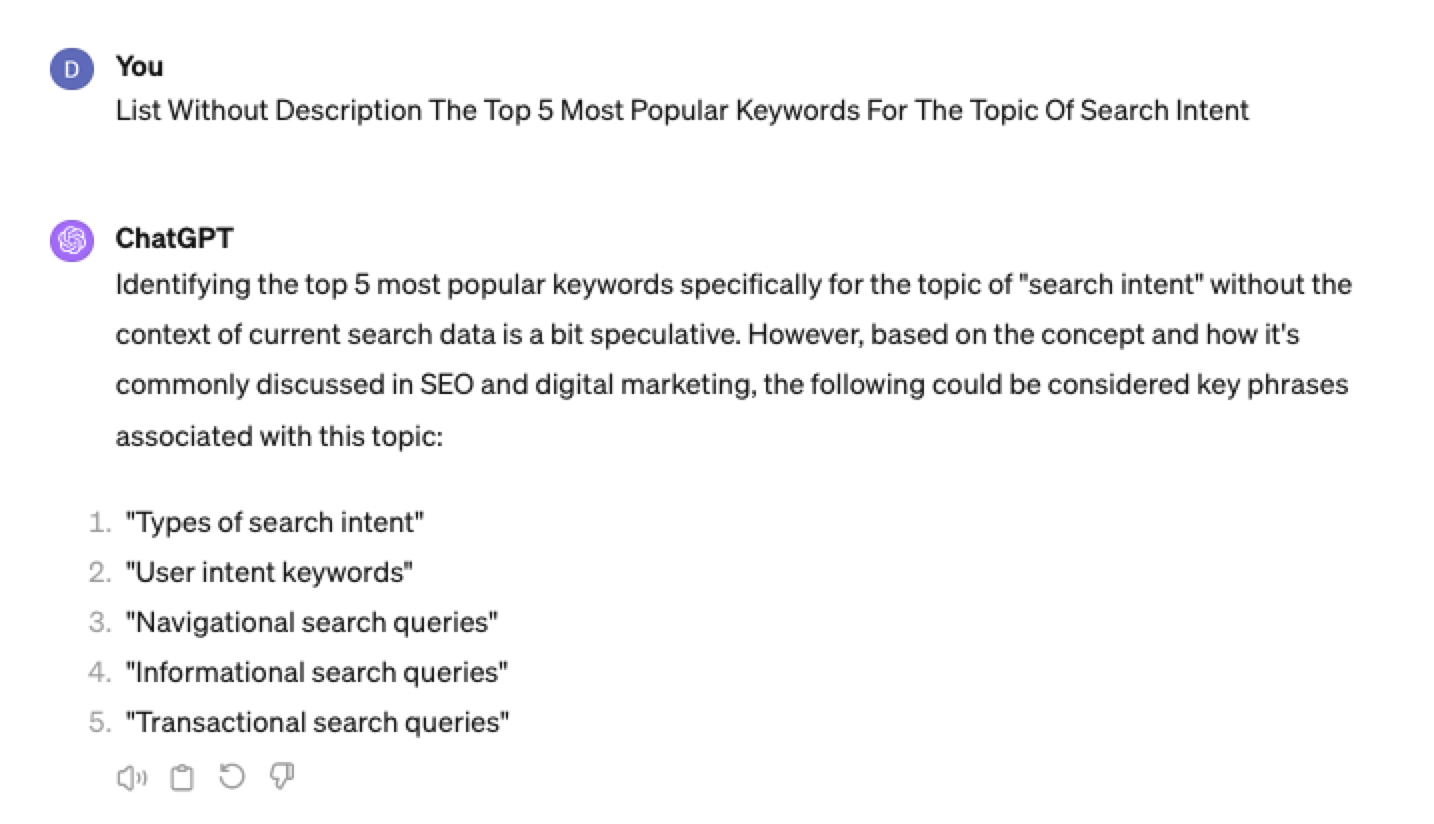 Screenshot ChatGPT 4,April 2024
Screenshot ChatGPT 4,April 2024List Without Description The Top Semantically Related Keywords And Entities For The Topic {X}
You can even ask ChatGPT what any topic’s semantically related keywords and entities are!
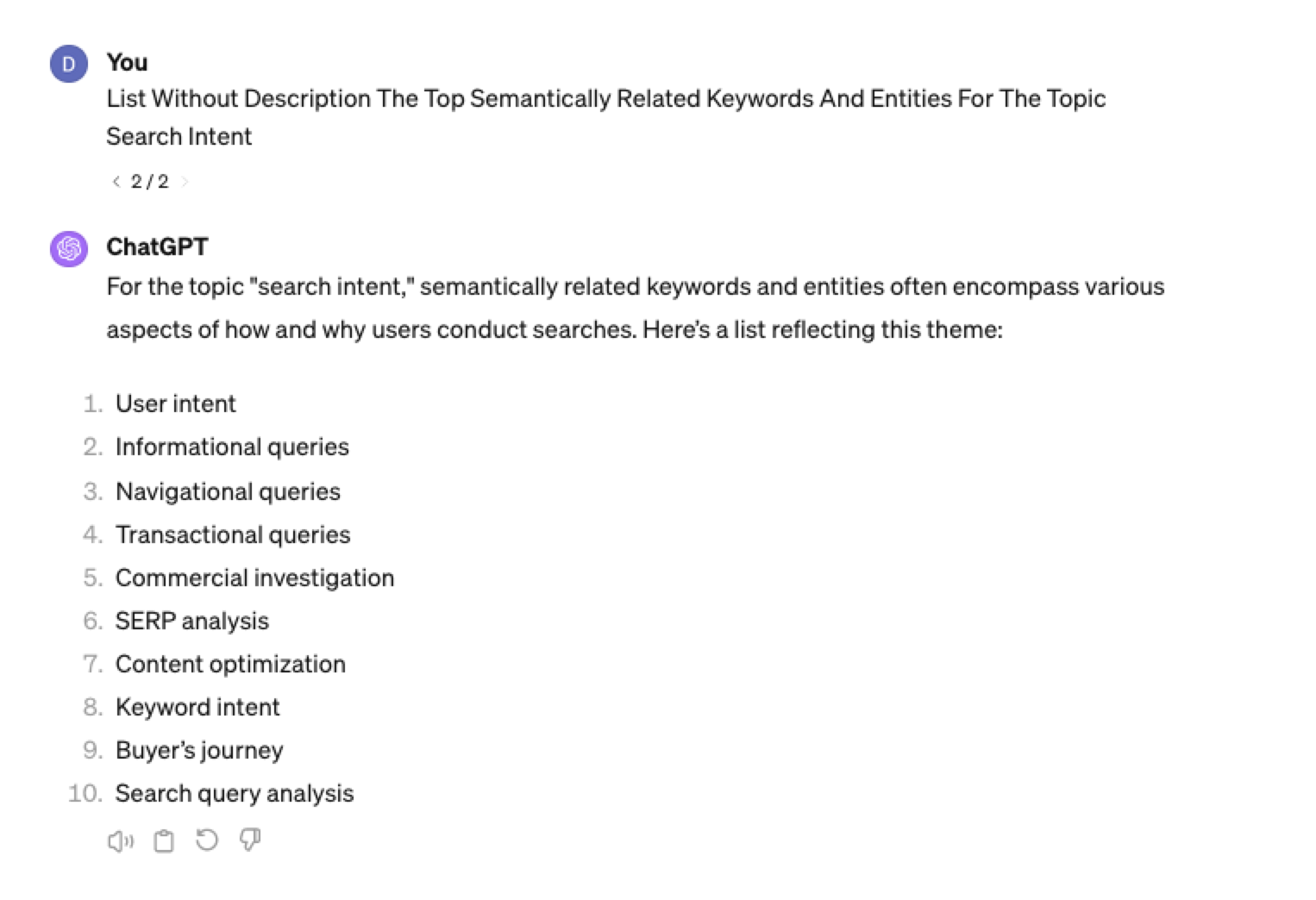 Screenshot ChatGPT 4, April 2024
Screenshot ChatGPT 4, April 2024Tip: The Onion Method Of Prompting ChatGPT
When you are happy with a series of prompts, add them all to one prompt. For example, so far in this article, we have asked ChatGPT the following:
- What are the four most popular sub-topics related to SEO?
- What are the four most popular sub-topics related to keyword research
- List without description the top five most popular keywords for “keyword intent”?
- List without description the top five most popular long-tail keywords for the topic “keyword intent types”?
- List without description the top semantically related keywords and entities for the topic “types of keyword intent in SEO.”
Combine all five into one prompt by telling ChatGPT to perform a series of steps. Example:
“Perform the following steps in a consecutive order Step 1, Step 2, Step 3, Step 4, and Step 5”
Example:
“Perform the following steps in a consecutive order Step 1, Step 2, Step 3, Step 4 and Step 5. Step 1 – Generate an answer for the 3 most popular sub-topics related to {Topic}?. Step 2 – Generate 3 of the most popular sub-topics related to each answer. Step 3 – Take those answers and list without description their top 3 most popular keywords. Step 4 – For the answers given of their most popular keywords, provide 3 long-tail keywords. Step 5 – for each long-tail keyword offered in the response, a list without descriptions 3 of their top semantically related keywords and entities.”
Generating Keyword Ideas Based On A Question
Taking the steps approach from above, we can get ChatGPT to help streamline getting keyword ideas based on a question. For example, let’s ask, “What is SEO?”
“Perform the following steps in a consecutive order Step 1, Step 2, Step 3, and Step 4. Step 1 Generate 10 questions about “{Question}”?. Step 2 – Generate 5 more questions about “{Question}” that do not repeat the above. Step 3 – Generate 5 more questions about “{Question}” that do not repeat the above. Step 4 – Based on the above Steps 1,2,3 suggest a final list of questions avoiding duplicates or semantically similar questions.”
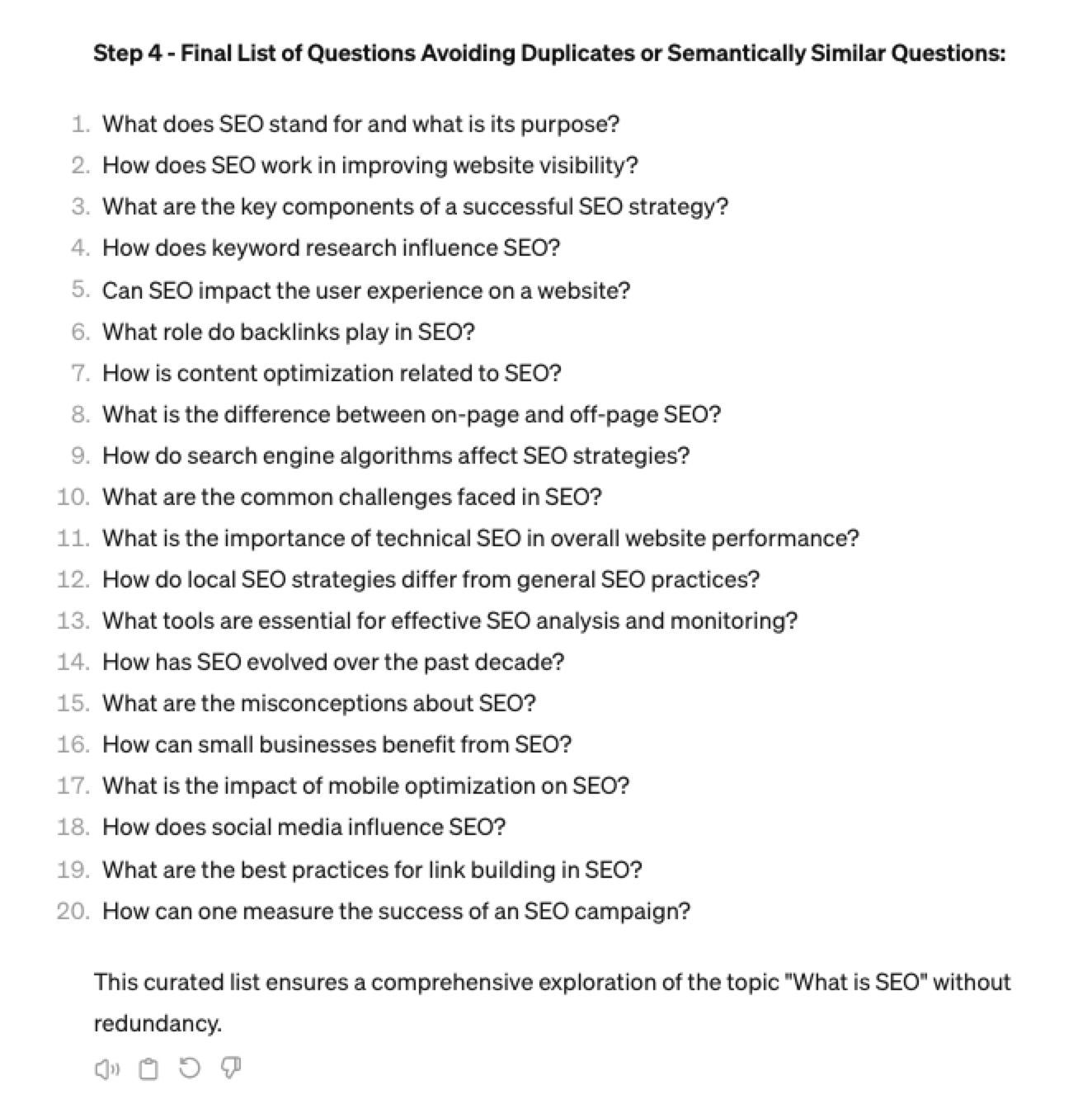 Screenshot ChatGPT 4, April 2024
Screenshot ChatGPT 4, April 2024Generating Keyword Ideas Using ChatGPT Based On The Alphabet Soup Method
One of my favorite methods, manually, without even using a keyword research tool, is to generate keyword research ideas from Google autocomplete, going from A to Z.
-
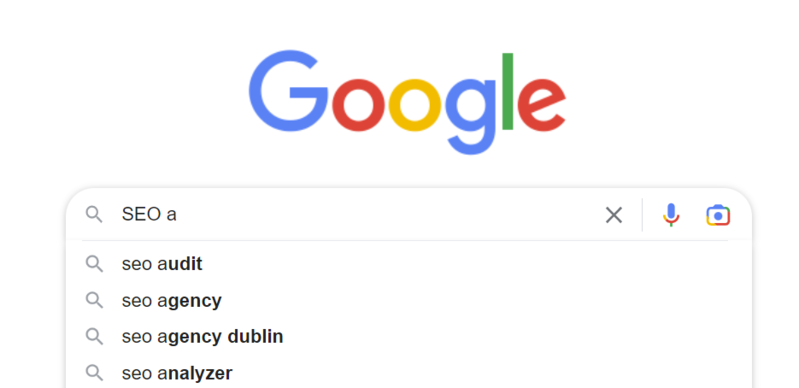 Screenshot from Google autocomplete, April 2024
Screenshot from Google autocomplete, April 2024
You can also do this using ChatGPT.
Example prompt:
“give me popular keywords that includes the keyword “SEO”, and the next letter of the word starts with a”
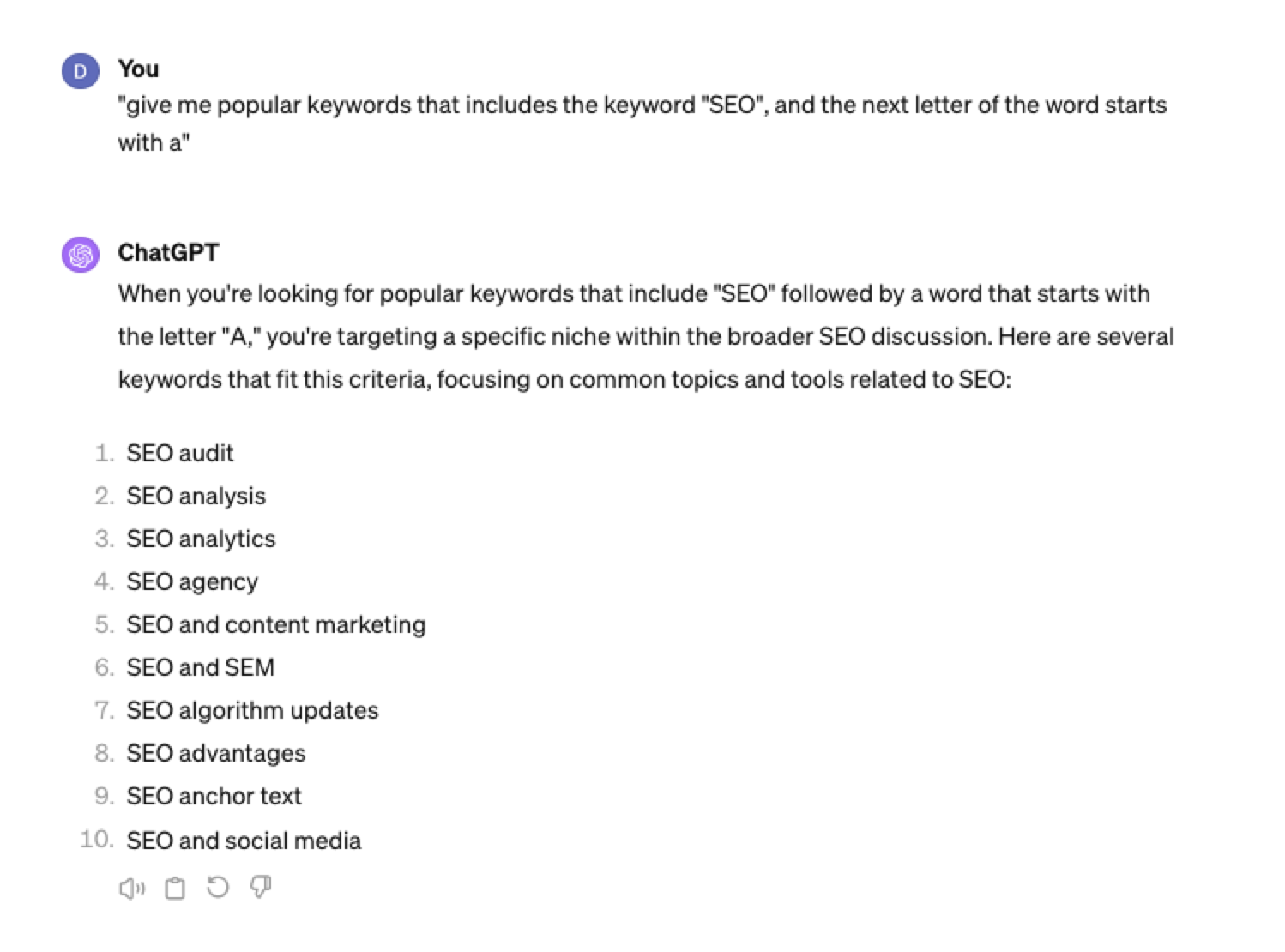 Screenshot from ChatGPT 4, April 2024
Screenshot from ChatGPT 4, April 2024Tip: Using the onion prompting method above, we can combine all this in one prompt.
“Give me five popular keywords that include “SEO” in the word, and the following letter starts with a. Once the answer has been done, move on to giving five more popular keywords that include “SEO” for each letter of the alphabet b to z.”
Generating Keyword Ideas Based On User Personas
When it comes to keyword research, understanding user personas is essential for understanding your target audience and keeping your keyword research focused and targeted. ChatGPT may help you get an initial understanding of customer personas.
Example prompt:
“For the topic of “{Topic}” list 10 keywords each for the different types of user personas”
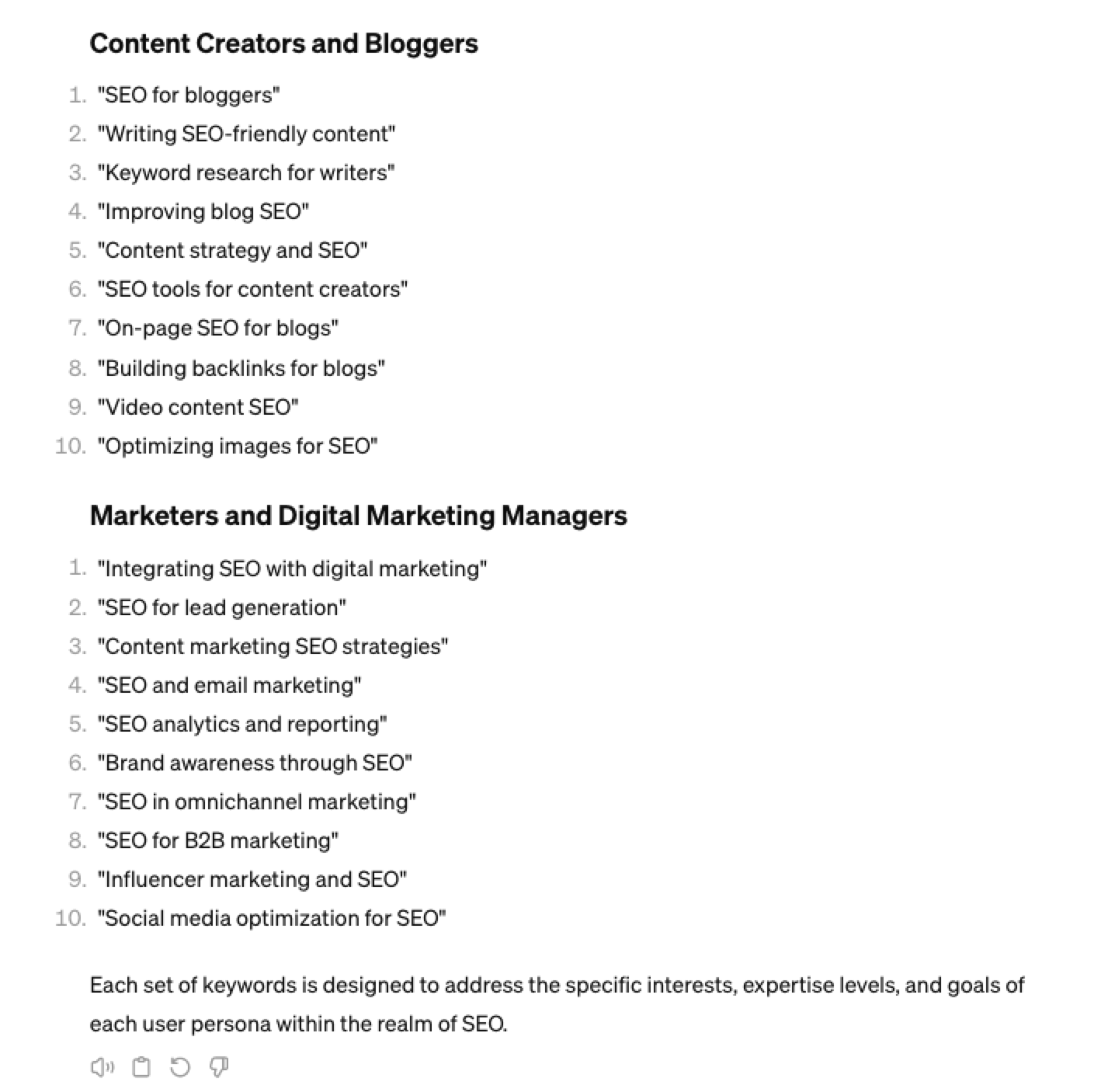 Screenshot from ChatGPT 4, April 2024
Screenshot from ChatGPT 4, April 2024You could even go a step further and ask for questions based on those topics that those specific user personas may be searching for:
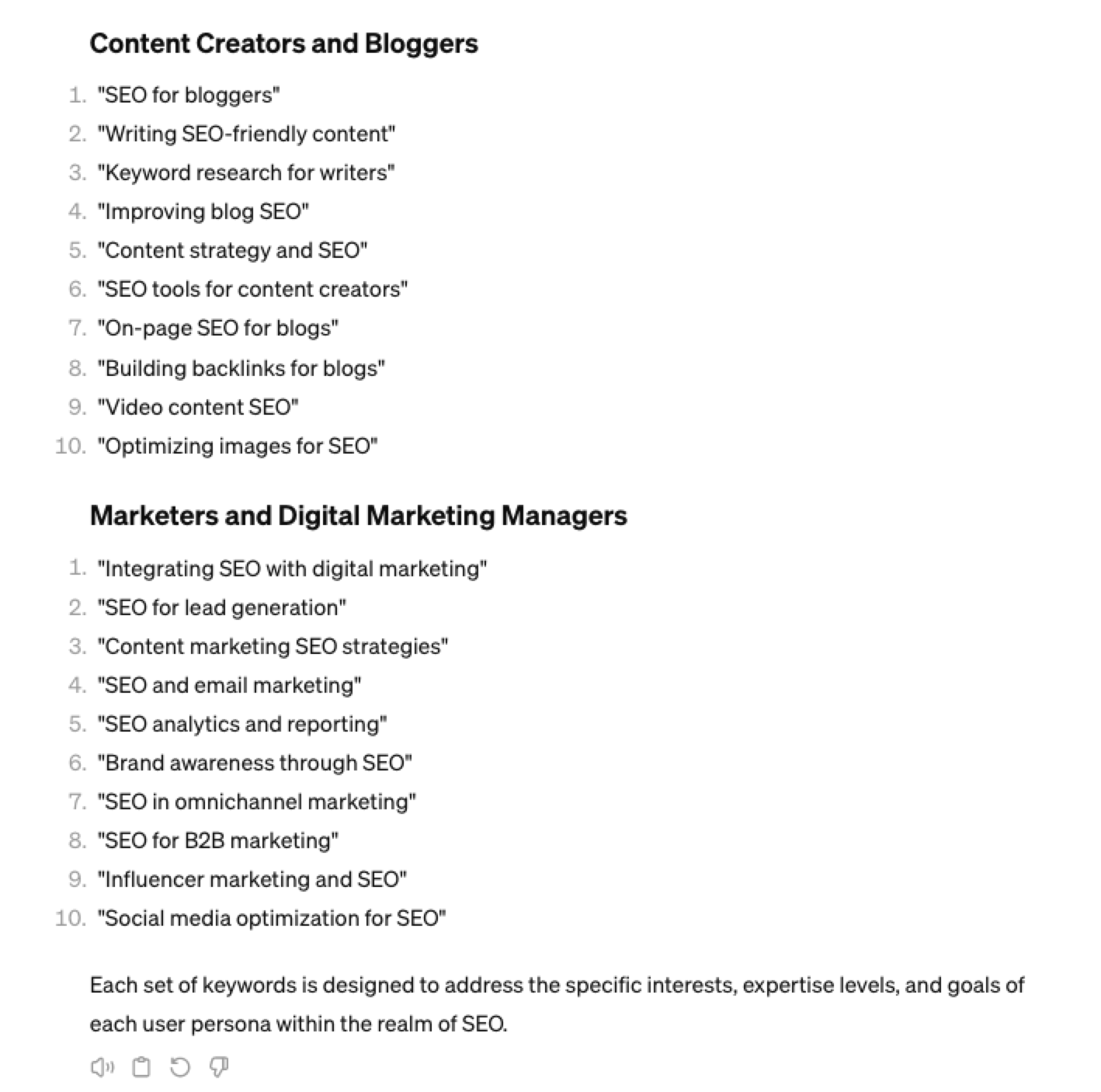 Screenshot ChatGPT 4, April 2024
Screenshot ChatGPT 4, April 2024As well as get the keywords to target based on those questions:
“For each question listed above for each persona, list the keywords, as well as the long-tail keywords to target, and put them in a table”
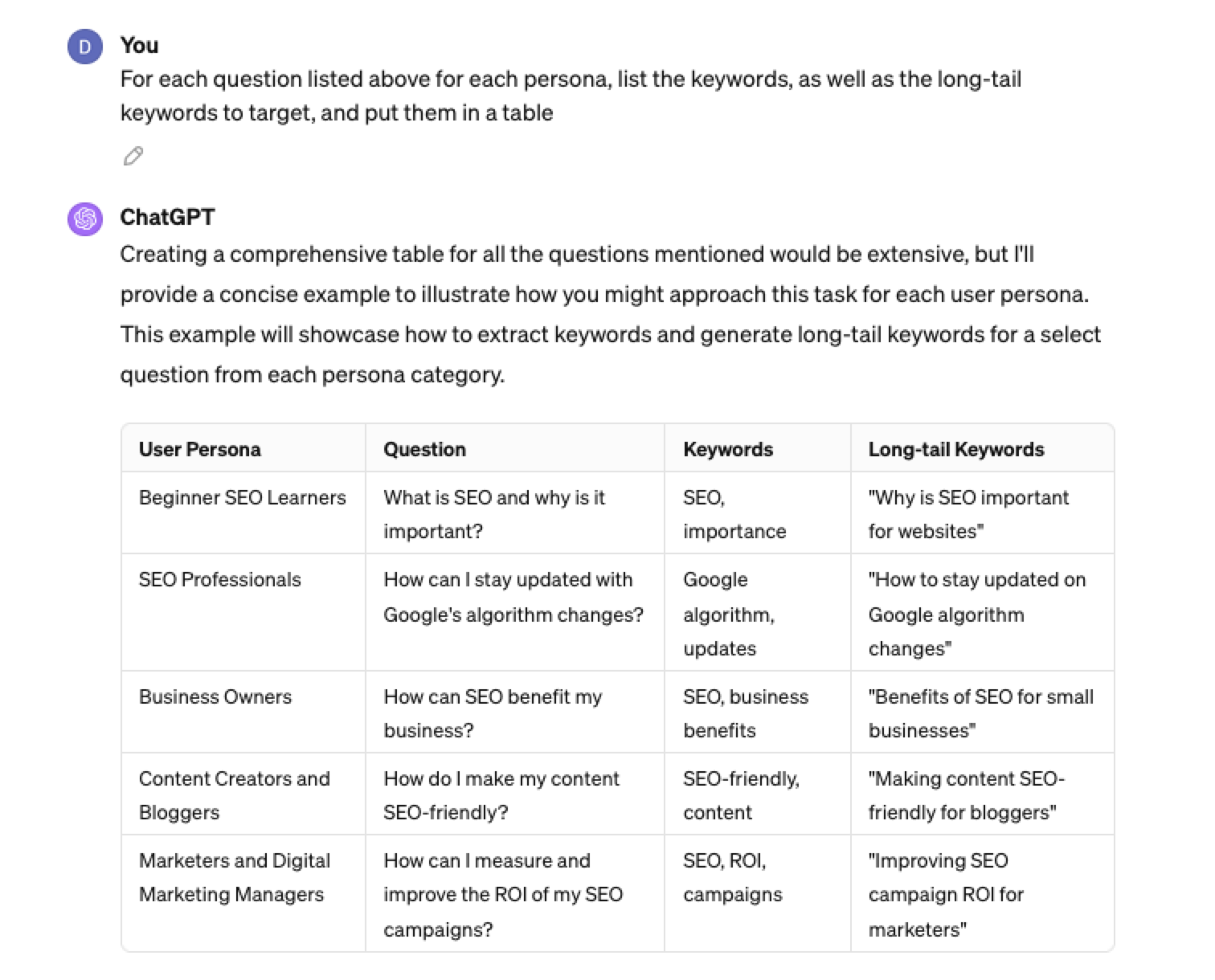 Screenshot from ChatGPT 4, April 2024
Screenshot from ChatGPT 4, April 2024Generating Keyword Ideas Using ChatGPT Based On Searcher Intent And User Personas
Understanding the keywords your target persona may be searching is the first step to effective keyword research. The next step is to understand the search intent behind those keywords and which content format may work best.
For example, a business owner who is new to SEO or has just heard about it may be searching for “what is SEO.”
However, if they are further down the funnel and in the navigational stage, they may search for “top SEO firms.”
You can query ChatGPT to inspire you here based on any topic and your target user persona.
SEO Example:
“For the topic of “{Topic}” list 10 keywords each for the different types of searcher intent that a {Target Persona} would be searching for”
ChatGPT For Keyword Research Admin
Here is how you can best use ChatGPT for keyword research admin tasks.
Using ChatGPT As A Keyword Categorization Tool
One of the use cases for using ChatGPT is for keyword categorization.
In the past, I would have had to devise spreadsheet formulas to categorize keywords or even spend hours filtering and manually categorizing keywords.
ChatGPT can be a great companion for running a short version of this for you.
Let’s say you have done keyword research in a keyword research tool, have a list of keywords, and want to categorize them.
You could use the following prompt:
“Filter the below list of keywords into categories, target persona, searcher intent, search volume and add information to a six-column table: List of keywords – [LIST OF KEYWORDS], Keyword Search Volume [SEARCH VOLUMES] and Keyword Difficulties [KEYWORD DIFFICUTIES].”
-
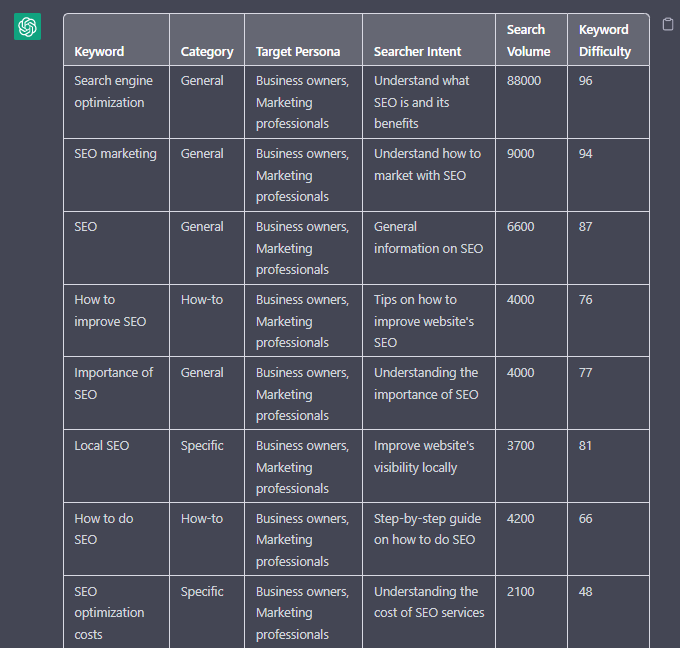 Screenshot from ChatGPT, April 2024
Screenshot from ChatGPT, April 2024
Tip: Add keyword metrics from the keyword research tools, as using the search volumes that a ChatGPT prompt may give you will be wildly inaccurate at best.
Using ChatGPT For Keyword Clustering
Another of ChatGPT’s use cases for keyword research is to help you cluster. Many keywords have the same intent, and by grouping related keywords, you may find that one piece of content can often target multiple keywords at once.
However, be careful not to rely only on LLM data for clustering. What ChatGPT may cluster as a similar keyword, the SERP or the user may not agree with. But it is a good starting point.
The big downside of using ChatGPT for keyword clustering is actually the amount of keyword data you can cluster based on the memory limits.
So, you may find a keyword clustering tool or script that is better for large keyword clustering tasks. But for small amounts of keywords, ChatGPT is actually quite good.
A great use small keyword clustering use case using ChatGPT is for grouping People Also Ask (PAA) questions.
Use the following prompt to group keywords based on their semantic relationships. For example:
“Organize the following keywords into groups based on their semantic relationships, and give a short name to each group: [LIST OF PAA], create a two-column table where each keyword sits on its own row.
-
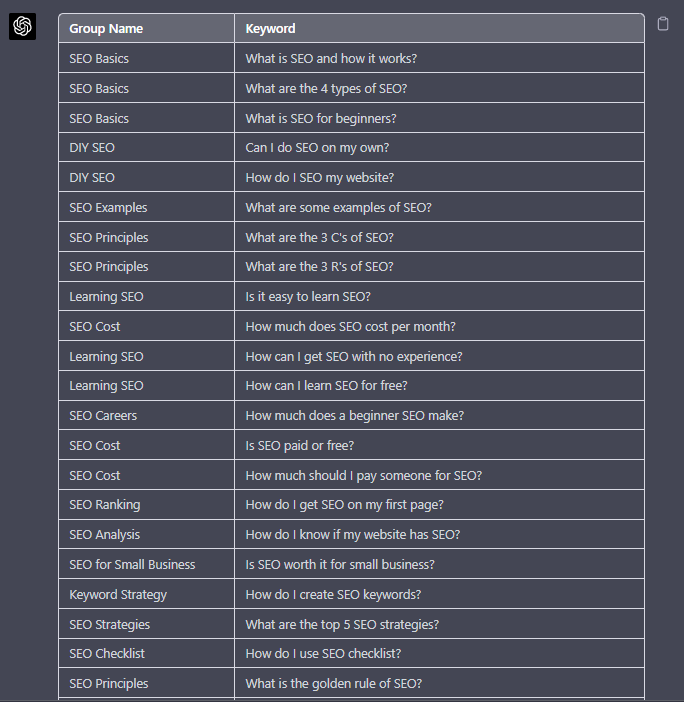 Screenshot from ChatGPT, April 2024
Screenshot from ChatGPT, April 2024
Using Chat GPT For Keyword Expansion By Patterns
One of my favorite methods of doing keyword research is pattern spotting.
Most seed keywords have a variable that can expand your target keywords.
Here are a few examples of patterns:
1. Question Patterns
(who, what, where, why, how, are, can, do, does, will)
“Generate [X] keywords for the topic “[Topic]” that contain any or all of the following “who, what, where, why, how, are, can, do, does, will”
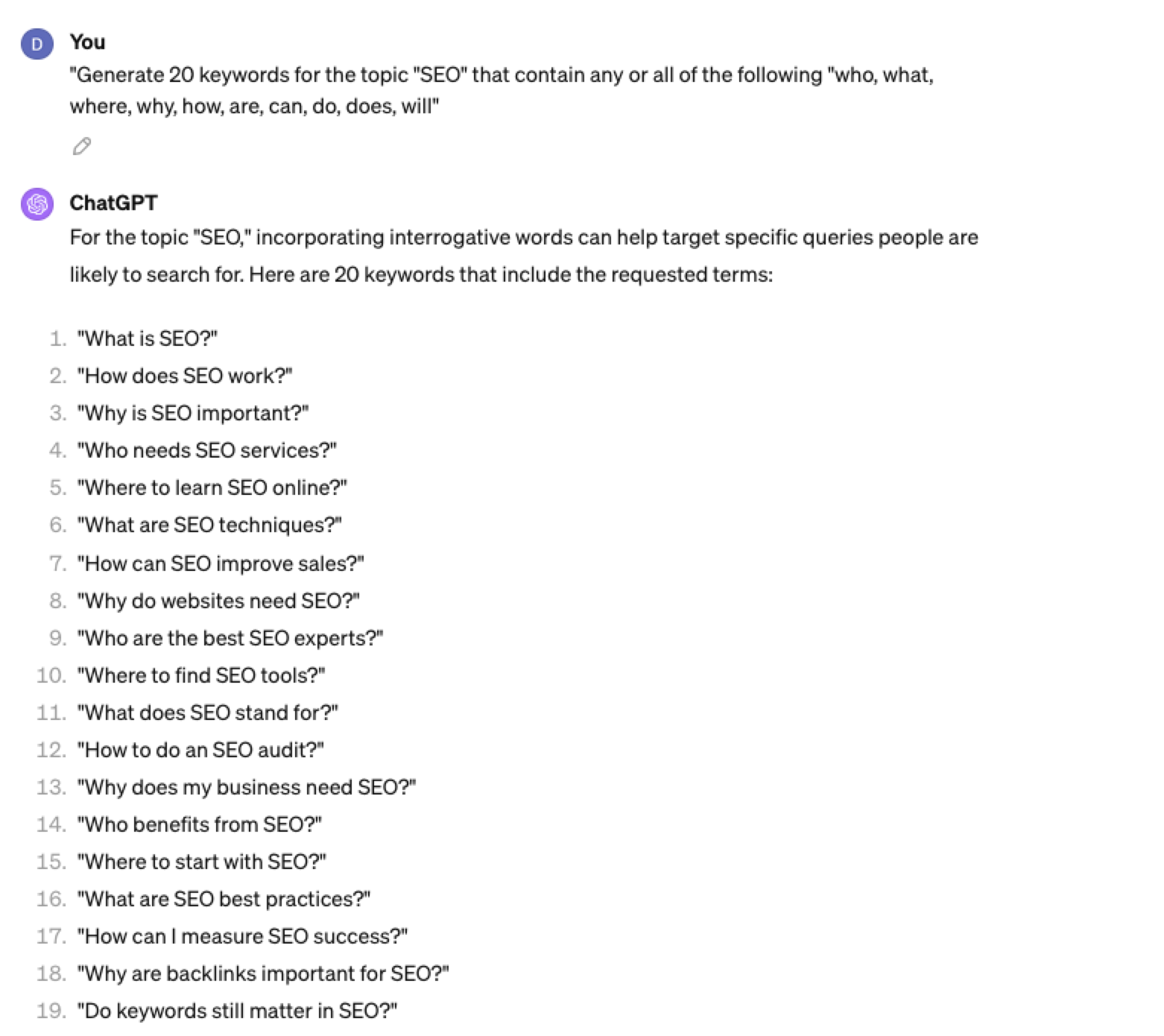 Screenshot ChatGPT 4, April 2024
Screenshot ChatGPT 4, April 20242. Comparison Patterns
Example:
“Generate 50 keywords for the topic “{Topic}” that contain any or all of the following “for, vs, alternative, best, top, review”
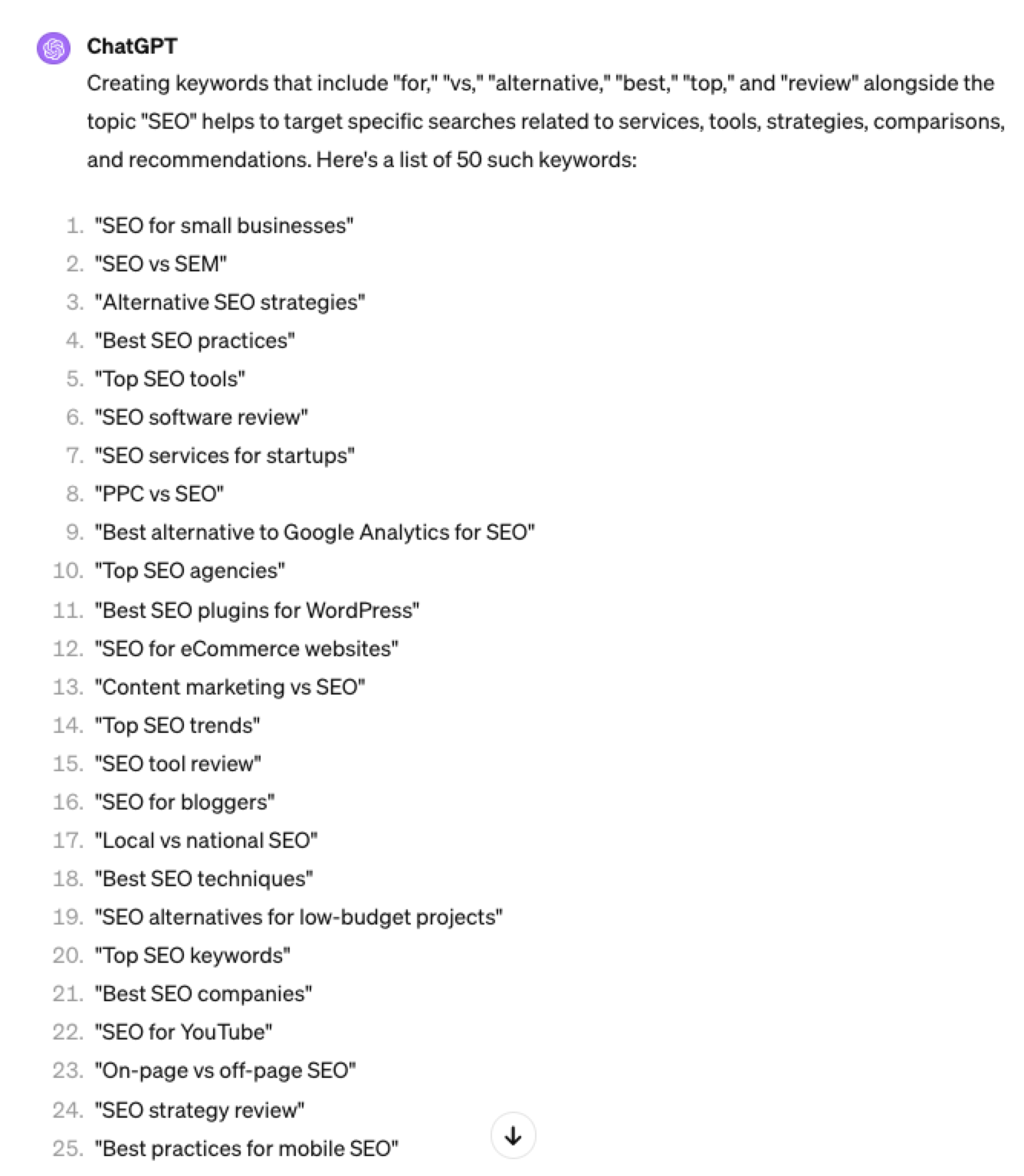 Screenshot ChatGPT 4, April 2024
Screenshot ChatGPT 4, April 20243. Brand Patterns
Another one of my favorite modifiers is a keyword by brand.
We are probably all familiar with the most popular SEO brands; however, if you aren’t, you could ask your AI friend to do the heavy lifting.
Example prompt:
“For the top {Topic} brands what are the top “vs” keywords”
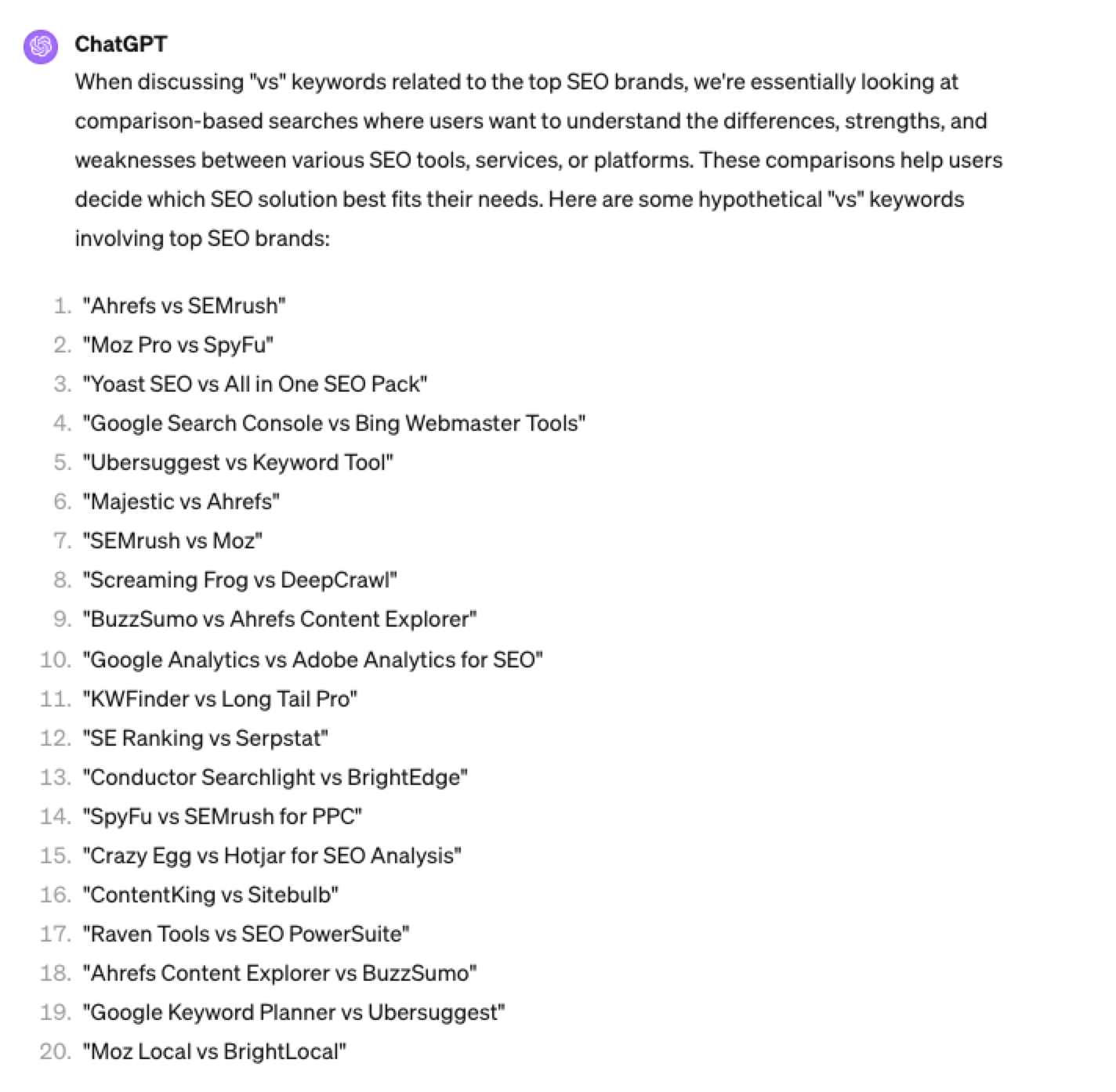 Screenshot ChatGPT 4, April 2024
Screenshot ChatGPT 4, April 20244. Search Intent Patterns
One of the most common search intent patterns is “best.”
When someone is searching for a “best {topic}” keyword, they are generally searching for a comprehensive list or guide that highlights the top options, products, or services within that specific topic, along with their features, benefits, and potential drawbacks, to make an informed decision.
Example:
“For the topic of “[Topic]” what are the 20 top keywords that include “best”
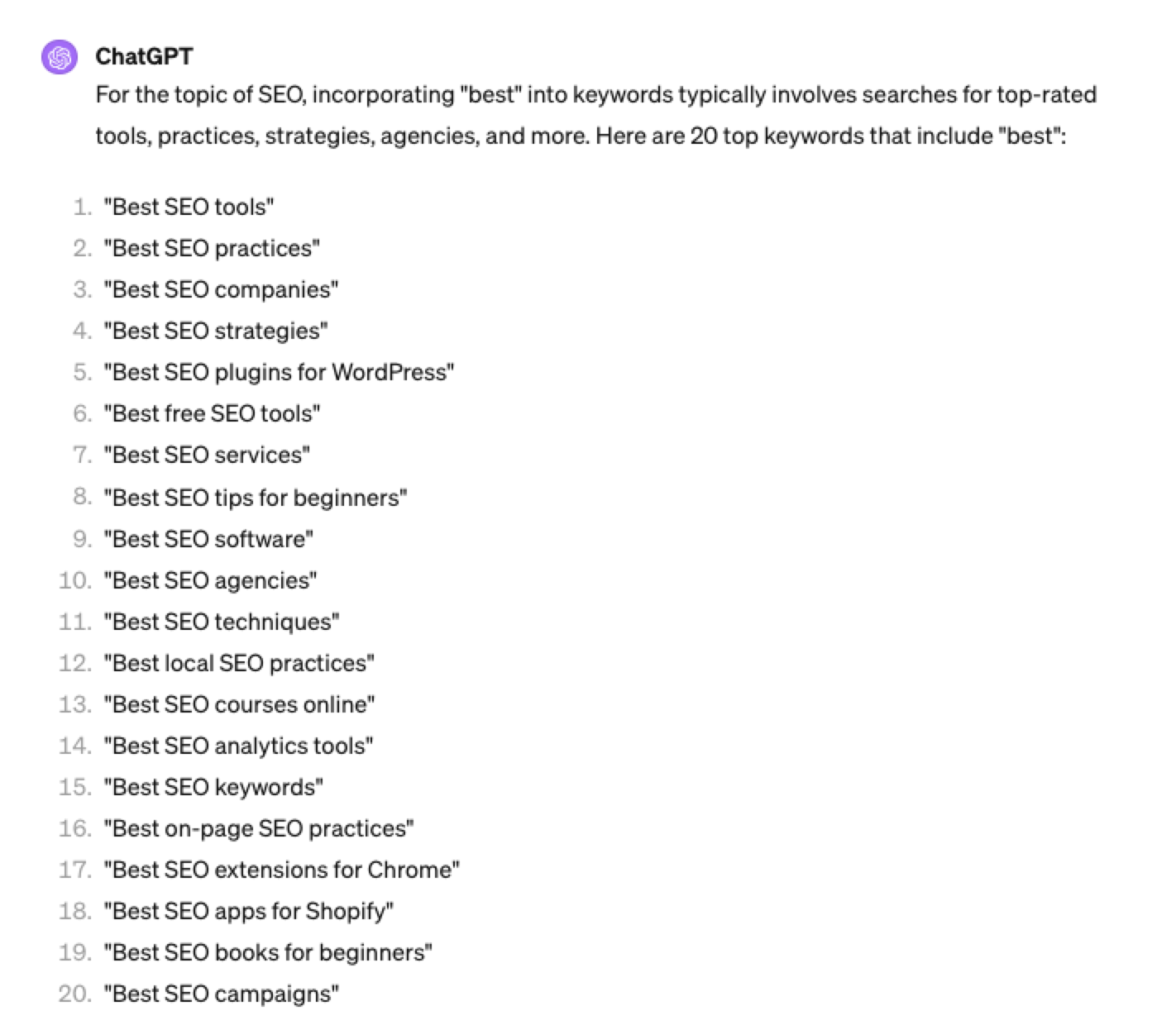 Screenshot ChatGPT 4, April 2024
Screenshot ChatGPT 4, April 2024Again, this guide to keyword research using ChatGPT has emphasized the ease of generating keyword research ideas by utilizing ChatGPT throughout the process.
Keyword Research Using ChatGPT Vs. Keyword Research Tools
Free Vs. Paid Keyword Research Tools
Like keyword research tools, ChatGPT has free and paid options.
However, one of the most significant drawbacks of using ChatGPT for keyword research alone is the absence of SEO metrics to help you make smarter decisions.
To improve accuracy, you could take the results it gives you and verify them with your classic keyword research tool – or vice versa, as shown above, uploading accurate data into the tool and then prompting.
However, you must consider how long it takes to type and fine-tune your prompt to get your desired data versus using the filters within popular keyword research tools.
For example, if we use a popular keyword research tool using filters, you could have all of the “best” queries with all of their SEO metrics:
-
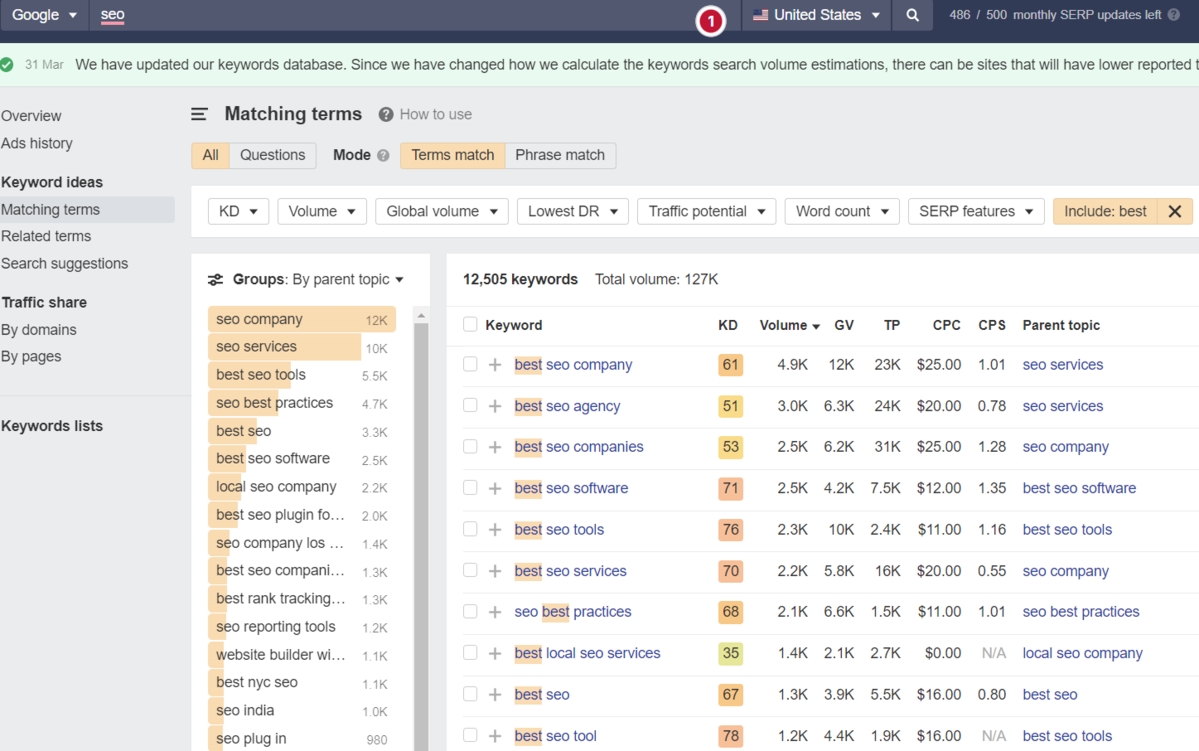 Screenshot from Ahrefs Keyword Explorer, March 2024
Screenshot from Ahrefs Keyword Explorer, March 2024
And unlike ChatGPT, generally, there is no token limit; you can extract several hundred, if not thousands, of keywords at a time.
As I have mentioned multiple times throughout this piece, you cannot blindly trust the data or SEO metrics it may attempt to provide you with.
The key is to validate the keyword research with a keyword research tool.
ChatGPT For International SEO Keyword Research
ChatGPT can be a terrific multilingual keyword research assistant.
For example, if you wanted to research keywords in a foreign language such as French. You could ask ChatGPT to translate your English keywords;
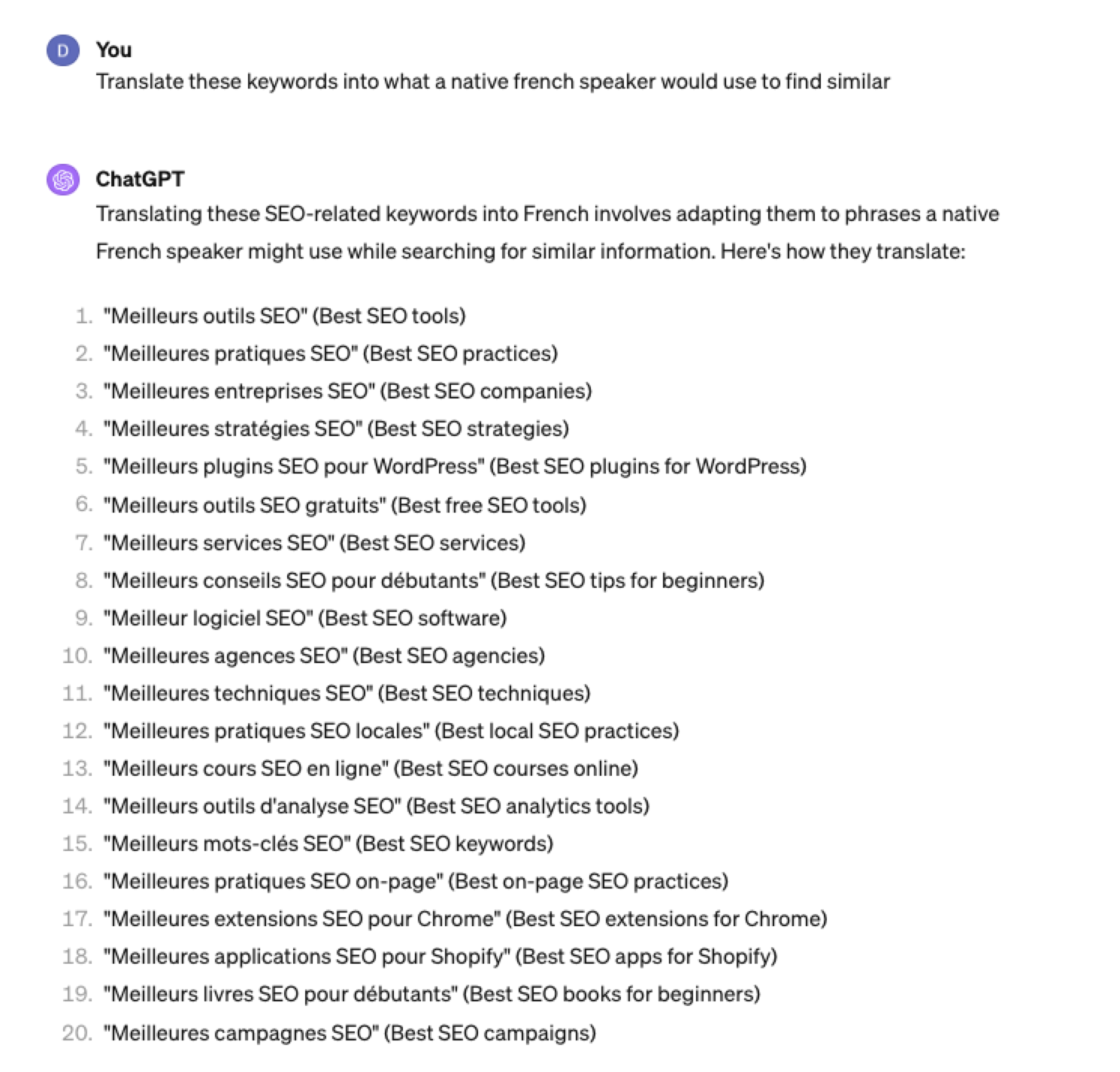 Screenshot ChatGPT 4, Apil 2024
Screenshot ChatGPT 4, Apil 2024- The key is to take the data above and paste it into a popular keyword research tool to verify.
- As you can see below, many of the keyword translations for the English keywords do not have any search volume for direct translations in French.
 Screenshot from Ahrefs Keyword Explorer, April 2024
Screenshot from Ahrefs Keyword Explorer, April 2024But don’t worry, there is a workaround: If you have access to a competitor keyword research tool, you can see what webpage is ranking for that query – and then identify the top keyword for that page based on the ChatGPT translated keywords that do have search volume.
-
-
 Screenshot from Ahrefs Keyword Explorer, April 2024
Screenshot from Ahrefs Keyword Explorer, April 2024
Or, if you don’t have access to a paid keyword research tool, you could always take the top-performing result, extract the page copy, and then ask ChatGPT what the primary keyword for the page is.
Key Takeaway
-
ChatGPT can be an expert on any topic and an invaluable keyword research tool. However, it is another tool to add to your toolbox when doing keyword research; it does not replace traditional keyword research tools.
As shown throughout this tutorial, from making up keywords at the beginning to inaccuracies around data and translations, ChatGPT can make mistakes when used for keyword research.
You cannot blindly trust the data you get back from ChatGPT.
However, it can offer a shortcut to understanding any topic for which you need to do keyword research and, as a result, save you countless hours.
But the key is how you prompt.
The prompts I shared with you above will help you understand a topic in minutes instead of hours and allow you to better seed keywords using keyword research tools.
It can even replace mundane keyword clustering tasks that you used to do with formulas in spreadsheets or generate ideas based on keywords you give it.
Paired with traditional keyword research tools, ChatGPT for keyword research can be a powerful tool in your arsenal.
More resources:
Featured Image: Tatiana Shepeleva/Shutterstock
SEO
OpenAI Expected to Integrate Real-Time Data In ChatGPT

Sam Altman, CEO of OpenAI, dispelled rumors that a new search engine would be announced on Monday, May 13. Recent deals have raised the expectation that OpenAI will announce the integration of real-time content from English, Spanish, and French publications into ChatGPT, complete with links to the original sources.
OpenAI Search Is Not Happening
Many competing search engines have tried and failed to challenge Google as the leading search engine. A new wave of hybrid generative AI search engines is currently trying to knock Google from the top spot with arguably very little success.
Sam Altman is on record saying that creating a search engine to compete against Google is not a viable approach. He suggested that technological disruption was the way to replace Google by changing the search paradigm altogether. The speculation that Altman is going to announce a me-too search engine on Monday never made sense given his recent history of dismissing the concept as a non-starter.
So perhaps it’s not a surprise that he recently ended the speculation by explicitly saying that he will not be announcing a search engine on Monday.
He tweeted:
“not gpt-5, not a search engine, but we’ve been hard at work on some new stuff we think people will love! feels like magic to me.”
“New Stuff” May Be Iterative Improvement
It’s quite likely that what’s going to be announced is iterative which means it improves ChatGPT but not replaces it. This fits into how Altman recently expressed his approach with ChatGPT.
He remarked:
“And it does kind of suck to ship a product that you’re embarrassed about, but it’s much better than the alternative. And in this case in particular, where I think we really owe it to society to deploy iteratively.
There could totally be things in the future that would change where we think iterative deployment isn’t such a good strategy, but it does feel like the current best approach that we have and I think we’ve gained a lot from from doing this and… hopefully the larger world has gained something too.”
Improving ChatGPT iteratively is Sam Altman’s preference and recent clues point to what those changes may be.
Recent Deals Contain Clues
OpenAI has been making deals with news media and User Generated Content publishers since December 2023. Mainstream media has reported these deals as being about licensing content for training large language models. But they overlooked a a key detail that we reported on last month which is that these deals give OpenAI access to real-time information that they stated will be used to give attribution to that real-time data in the form of links.
That means that ChatGPT users will gain the ability to access real-time news and to use that information creatively within ChatGPT.
Dotdash Meredith Deal
Dotdash Meredith (DDM) is the publisher of big brand publications such as Better Homes & Gardens, FOOD & WINE, InStyle, Investopedia, and People magazine. The deal that was announced goes way beyond using the content as training data. The deal is explicitly about surfacing the Dotdash Meredith content itself in ChatGPT.
The announcement stated:
“As part of the agreement, OpenAI will display content and links attributed to DDM in relevant ChatGPT responses. …This deal is a testament to the great work OpenAI is doing on both fronts to partner with creators and publishers and ensure a healthy Internet for the future.
Over 200 million Americans each month trust our content to help them make decisions, solve problems, find inspiration, and live fuller lives. This partnership delivers the best, most relevant content right to the heart of ChatGPT.”
A statement from OpenAI gives credibility to the speculation that OpenAI intends to directly show licensed third-party content as part of ChatGPT answers.
OpenAI explained:
“We’re thrilled to partner with Dotdash Meredith to bring its trusted brands to ChatGPT and to explore new approaches in advancing the publishing and marketing industries.”
Something that DDM also gets out of this deal is that OpenAI will enhance DDM’s in-house ad targeting in order show more tightly focused contextual advertising.
Le Monde And Prisa Media Deals
In March 2024 OpenAI announced a deal with two global media companies, Le Monde and Prisa Media. Le Monde is a French news publication and Prisa Media is a Spanish language multimedia company. The interesting aspects of these two deals is that it gives OpenAI access to real-time data in French and Spanish.
Prisa Media is a global Spanish language media company based in Madrid, Spain that is comprised of magazines, newspapers, podcasts, radio stations, and television networks. It’s reach extends from Spain to America. American media companies include publications in the United States, Argentina, Bolivia, Chile, Colombia, Costa Rica, Ecuador, Mexico, and Panama. That is a massive amount of real-time information in addition to a massive audience of millions.
OpenAI explicitly announced that the purpose of this deal was to bring this content directly to ChatGPT users.
The announcement explained:
“We are continually making improvements to ChatGPT and are supporting the essential role of the news industry in delivering real-time, authoritative information to users. …Our partnerships will enable ChatGPT users to engage with Le Monde and Prisa Media’s high-quality content on recent events in ChatGPT, and their content will also contribute to the training of our models.”
That deal is not just about training data. It’s about bringing current events data to ChatGPT users.
The announcement elaborated in more detail:
“…our goal is to enable ChatGPT users around the world to connect with the news in new ways that are interactive and insightful.”
As noted in our April 30th article that revealed that OpenAI will show links in ChatGPT, OpenAI intends to show third party content with links to that content.
OpenAI commented on the purpose of the Le Monde and Prisa Media partnership:
“Over the coming months, ChatGPT users will be able to interact with relevant news content from these publishers through select summaries with attribution and enhanced links to the original articles, giving users the ability to access additional information or related articles from their news sites.”
There are additional deals with other groups like The Financial Times which also stress that this deal will result in a new ChatGPT feature that will allow users to interact with real-time news and current events .
OpenAI’s Monday May 13 Announcement
There are many clues that the announcement on Monday will be that ChatGPT users will gain the ability to interact with content about current events. This fits into the terms of recent deals with news media organizations. There may be other features announced as well but this part is something that there are many clues pointing to.
Watch Altman’s interview at Stanford University
Featured Image by Shutterstock/photosince
-

 PPC5 days ago
PPC5 days agoHow the TikTok Algorithm Works in 2024 (+9 Ways to Go Viral)
-

 SEO6 days ago
SEO6 days agoBlog Post Checklist: Check All Prior to Hitting “Publish”
-

 SEO4 days ago
SEO4 days agoHow to Use Keywords for SEO: The Complete Beginner’s Guide
-

 MARKETING5 days ago
MARKETING5 days agoHow To Protect Your People and Brand
-

 PPC6 days ago
PPC6 days agoHow to Craft Compelling Google Ads for eCommerce
-

 SEARCHENGINES6 days ago
SEARCHENGINES6 days agoGoogle Started Enforcing The Site Reputation Abuse Policy
-

 MARKETING4 days ago
MARKETING4 days agoThe Ultimate Guide to Email Marketing
-

 MARKETING6 days ago
MARKETING6 days agoElevating Women in SEO for a More Inclusive Industry


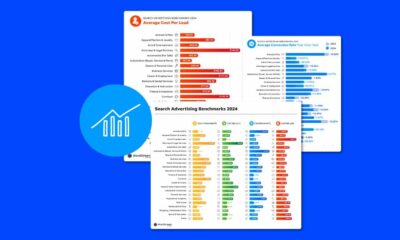

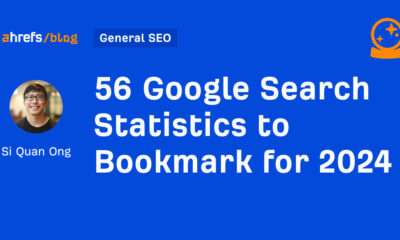







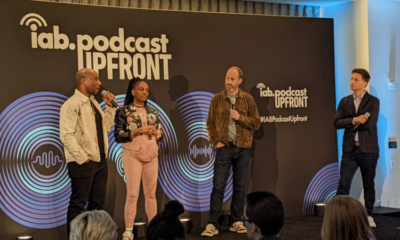



You must be logged in to post a comment Login